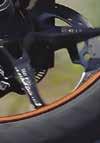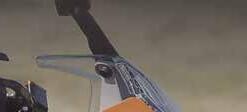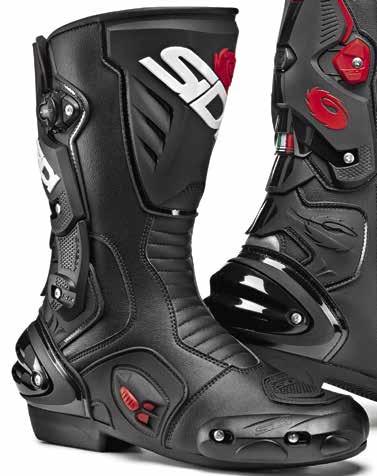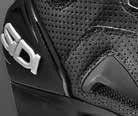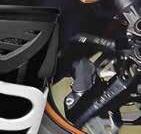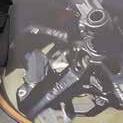




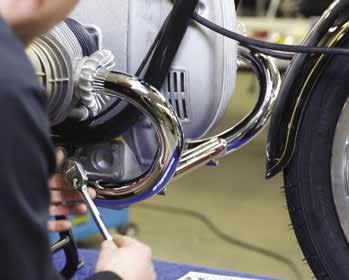
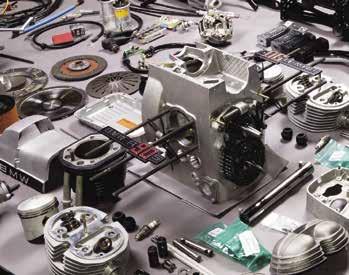

We also sell fully restored, partially restored, and project bikes. Huge used parts inventory. Learn more about our vintage BMW restoration and service and shop our parts catalog at www.maxbmw.com
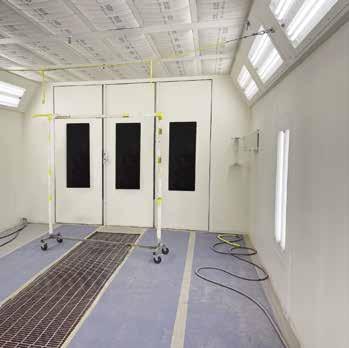 Fully-enclosed professional paint booth on-site
Full-service machine shop in-house
Vintage BMW-Certified Master Technicians
USA’s largest stock of new BMW Motorcycle parts
Fully-enclosed professional paint booth on-site
Full-service machine shop in-house
Vintage BMW-Certified Master Technicians
USA’s largest stock of new BMW Motorcycle parts
MIXING
WITH BUSINESS ABOARD BMWS
BY CHARLES RUBIN #207892HAPPENSTANCE AT THE SEDALIA RALLY (CLINT EASTWOOD SLEPT HERE!) BY ALAN TONEY #124362
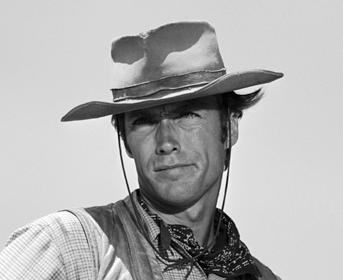
CROSSING THE LAKE LANDS TO THE CANADIAN SHIELD BY DUSTIN
SILVEY #2247784 | HEADLIGHT Bye, Bye, Winter by Bill Wiegand
8 | PRESIDENT'S COLUMN See You at Fontana by Reece Mullins
10 | POSTCARDS FROM THE ROAD
12 | RIDER TO RIDER Letters from our Members
14 | NEWS Meet your 2023 BMW MOA Board of Directors Candidates, BMW Motorrad walks back shop manual policy, BMW NA recalls S 1000 RRs for brake issue, BMW Motorrad presents the BMW CE 04 Vagabund Moto Concept, Roll with Dunlop and save $$, Welcome to the 50th National Rally, 10 Virginia Military History sites to visit.
20 | GEAR Camp Stoves
26 | GEAR Beat Old Man Winter with Hippo Hands by Mark Thompson
30 | GEAR Klim Badlands GTX Long Winter Gloves by Mark Barnes

ON THE COVER
36 | KEEP 'EM FLYING Flying into Spring by Matt Parkhouse
38 | TORQUE OF THE MATTER Do I Really Have to Upgrade my Suspension? By Wes Fleming
58 | RIDER SKILLS Safe Acceleration isn’t just about the Throttle by Nick Ienatsch

60 | Memories of Seafood Bisque, by Sue Rihn

64 | THE RIDE INSIDE Not What You Think by Mark Barnes
68 | CELEBRATING OUR 50TH ANNIVERSARY 50 Great Years of Memories!
70 | Welcome our Newest MOA Members
74 | WHEN AND WHERE Rally listings
79 | ADVERTISING INDEX
80 | TAILIGHT


Living here in the northern half of the country amid the tall pines and sky-blue waters, the cold fingers of Old Man Winter still maintain a chilling grasp on all those who live here. As the calendar closes in on April, freezing nighttime temperatures followed by daytime highs pushing 40 degrees tease motorcycle riders with the promise of a new season. Seeing mounds of snow and ice turn to rivulets of flowing water through a slow and deliberate process has been something I’ve enjoyed all my life. Punxsutawney Phil said we should be transitioning to spring by now, but the seemingly never-ending snow says, “Not quite yet.”
Besides melting snow, I’ve always seen the 40-pound bags of mulch for sale outside convenience stores as another sure sign of the next season. I saw the first neatly stacked piles of mulch last week and immediately felt my spirits rise–it doesn’t take much up here!
I traveled to BMW MOA headquarters in Greer, South Carolina, a week ago. Outside of dealing with the traffic on I-85, I love that part of the country, with its rolling hills, invigorating curvy roads and friendly southern hospitality. What I wasn’t prepared for was the weather! Trees were beginning to bud, and the bright yellow of blooming daffodils lined many roads I drove. The weatherman said record daytime highs could be set with 80 degrees, not something I’d seen since last October, and the winter clothes I mistakenly packed meant I’d be sweating a lot during my visit. I did!
Several years ago, I was taken to task by someone who took offense to my describing the riding “season” I’ve always known. Up here, the good riding typically runs from April until November. Then, the bike is serviced, parked, tethered to a battery tender, and longingly stared at until spring rains wash the salt and sand from the roads, making them ridable again. That person who scolded me obviously lives in the south, but truth be told, riding season to me is our fifth season of the year.
During my time in Greer, I realized he was correct, as in the south there isn’t a riding season as I know it, and riding is possible 12 months a year. Seeing riders on the streets of Greer made me jealous, but then I remembered those stacks of mulch I’d seen, which promised Wisconsin roads would soon be filled with riders.
Regardless of the telltale signs I’d seen of the impending new season, a glance at the MOA’s event calendar should give even the most dubious among us proof that the entire country will soon be out on the road.

Later this month, our Getaway season begins with the annual MOA Getaway at Fontana, always a personal favorite. Living in central Illinois, I counted down the days until this event. Surrounded by miles and miles of corn and soybean fields connected by roads seemingly laid by an engineer with a penchant for straight lines, I couldn’t wait to get to North Carolina to ride Deal’s Gap, the Cherohala Skyway and the Blue Ridge Parkway. Then, without fail, by the end of the Fontana Getaway, I’d had my fill of curves and longed for the straight roads of Illinois. Fontana is followed in early May with the MOA Getaway at Santa Fe, set amid the breathtaking red rock beauty of New Mexico.
Then in June comes our 50th National Rally slated for Doswell, Virginia, just outside Richmond. Jump forward to page 20 of this issue and see what Rally Chairs Wes and Paula Fitzer are planning. This rally is building up to be one of our best, and if you can fit it into your schedule, I know you will be glad you did.
Despite looking out my window and seeing yet more falling snow, I’m confident I’ll soon retire my snowblower for another season, and with it, the battery tender keeping my bike ready to roll.
Here’s to thumbs on starter buttons everywhere!



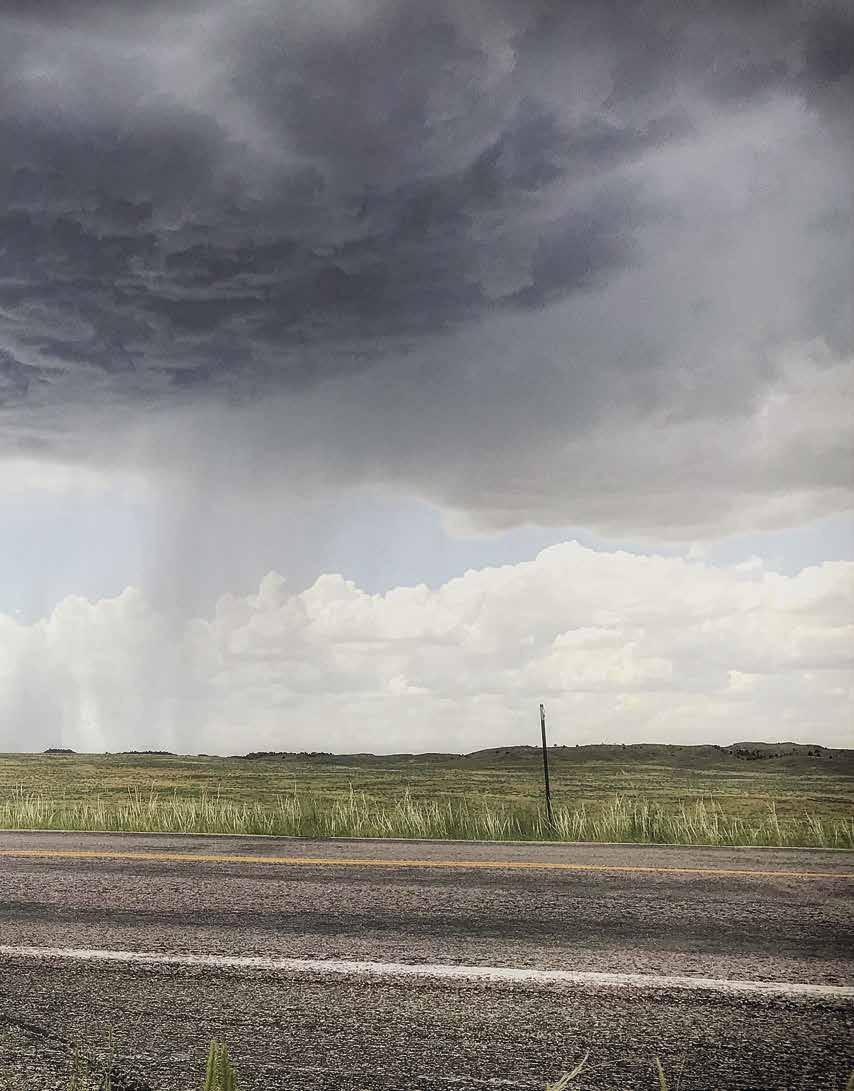
The HALO “bunny” goggles I was using for the first time prevented the 130+ mph winds from blowing my eyes shut and effectively blinding me as I leaned past the wind deflector of the Air Force C-130 Hercules troop transport I was performing jumpmaster duties on. As I put both feet fully on the jump platform, I was able to extend the entire length of my body outside the aircraft and entirely in the slipstream with an unhindered view of the beautiful Pacific Ocean 1000 feet below me. I didn’t know it then, but I was experiencing something that would remain firmly and uniquely etched in my memory for the rest of my life.
In many ways, our three-week, special-operations deployment to San Clemente Island off the coast of California forever changed my life. Hanging completely outside the aircraft, extending myself past the wind deflector for the first time, I was transfixed by the beauty of the Pacific Ocean (my first time seeing it). Deep sapphire blue aqua gave way to emerald green waters laced with the deeper sage of massive kelp forests. As we approached the island, I could see the rocky shores and the clear, cold waters into which I would soon find myself free-diving. The jump, for whatever reason, was canceled, and we air-landed instead. Days later, while conducting live-fire mortar operations, I realized this was a godsend. The drop zone we were going to use was comprised of boulders and cacti, and a bloody mess would have been the result had we jumped.
While on the island, I was handed a paperback book The Man Who Folded Himself by David Gerrold. An easy, short read with a unique perspective on the paradox of time travel. Like any decent time-travel novel, the constructs are too lengthy to discuss here, but I was struck with the concept that the main character would frequent a place where versions of himself, young and old, throughout his life would “pop” in and out of a room.
As I had the unique ability to frustrate my mortar section sergeant, he elected to “punish” me by leaving me on the island alone while the rest of mortars section flew to Camp Pendleton to cross-train with the Marines. Alone on an island with a box of MRE rations, 10 gallons of potable water, a good book, dive equipment, a cot surrounded by cacti, and the occasional endangered San Clemente fox to keep me company, I was one with nature. When I would get restless, I would saunter down to the craggy shore, don my wetsuit, and slip into the frigid waters, alone and unafraid; the great ocean beckoned me.

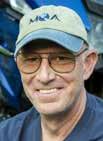
I often find myself harkening back to that San Clemente “getaway” years ago when I attend our annual MOA Fontana Getaway scheduled this year for April 21-22. I know that may sound odd, but the “gathering room” in the book is where I draw parallels. As we congregate each night in a room with two hundred fellow club members of differing ages, riding experience and backgrounds, it gives me pause and causes me to think that I’m really communing with different versions of myself at different stages of our riding journey. Motorcycle riders of every predilection pilgrimage to the Fontana valley to experience the undulating waves of pavement and the camaraderie of fellow riders.
Like the solitude I experienced diving alone in the beautiful and unfamiliar waters of the Pacific, riding the curvy, spring-time mountain roads that lead to Fontana strikes a familiar cathartic chord. I’ll be there again this year, looking forward to making new memories and conversing with various versions of my “self".
Reece Mullins #143779 President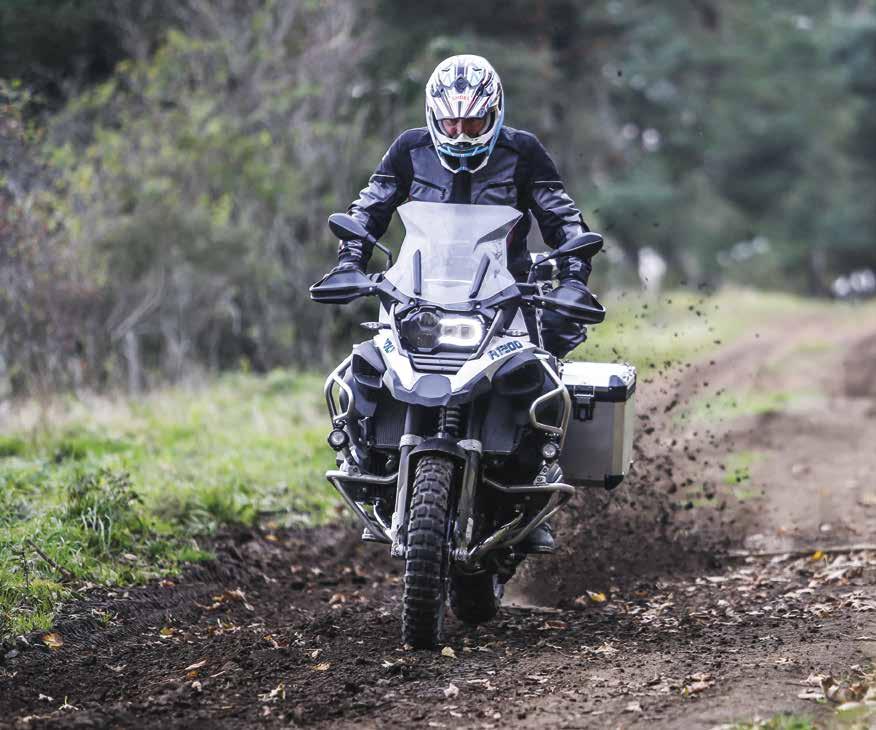
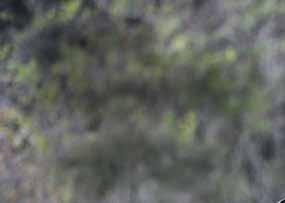
Each month we publish the great images sent to us by BMW MOA members from their travels around the globe. Send us your best images and you could have your work published in our Postcards from the Road pages. Email your high resolution images, image description and contact information to editor@bmwmoa.org.


 Left, My beloved G 450 X on the Slot Canyon Trail near Borrego Springs, California. Photo by Eric Deyerl #158472.
Bottom Left, Sunrise on the Blue Ridge Parkway. Photo by Mac Robinson #230224.
Bottom Right, Along Highway 93 at the border of British Columbia and Alberta woith Mt. Whymper rising in the background. Photo by Jim Wilson #215505.
Left, My beloved G 450 X on the Slot Canyon Trail near Borrego Springs, California. Photo by Eric Deyerl #158472.
Bottom Left, Sunrise on the Blue Ridge Parkway. Photo by Mac Robinson #230224.
Bottom Right, Along Highway 93 at the border of British Columbia and Alberta woith Mt. Whymper rising in the background. Photo by Jim Wilson #215505.



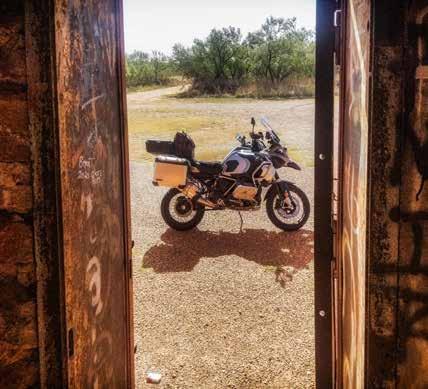 Top Left, A photo taken after dinner following two days of off-road training at the BMW Performance Center in Greer, South Carolina.
Photo by Scott Saunders #225224.
Bottom Left, No trip through northwest Texas is complete until you visit the Old Kent County Jail in Clairemont, Texas. Photo by Ross Thacker #2147951.
Top Right, Sneaking up on an F 18 at the Palm Springs Air Museum. Photo by Terry South #135779.
Top Left, A photo taken after dinner following two days of off-road training at the BMW Performance Center in Greer, South Carolina.
Photo by Scott Saunders #225224.
Bottom Left, No trip through northwest Texas is complete until you visit the Old Kent County Jail in Clairemont, Texas. Photo by Ross Thacker #2147951.
Top Right, Sneaking up on an F 18 at the Palm Springs Air Museum. Photo by Terry South #135779.
Don Wreyford’s letter in the February issue of BMW Owners News commenting on excessive high mileage, essentially riding 100,000 miles in one year, is a question I had pondered as well, wondering how on earth one could accomplish that!
My own experiences with over 600,000 kilometers, about 25,000 per year, had me reflecting on the broader picture, made me realize that, to a true enthusiast with the time and the deep pockets, it is actually quite easy to achieve.
For those who live in the southern states who do not have to face four or five months of winter storage, who are probably single and/or have taken a one-year break from the real world, here is how to go the distance.
Riding on a comfortable blend of throughways, state and county roads, one could essentially average 45 miles per hour during a 10-hour riding day. If that person were to ride for 40 weeks of the year (taking breaks here and there for 12 weeks) and then only ride 6 days each of the 40 weeks, that would actually total 108,000 miles.
Being retired in snowbound Canada, if I could get permission from my wife and find a sponsor, I would take on this challenge. It is doable.
James Stokes-Rees #230156 Saint John, New BrunswickI found the article on “First Aid Kits for Motorcyclists” timely, as many motorcyclists do not spare the room for a first aid kit.
Having a little experience with emergency medicine, there are a couple of basic items for every motorcyclist’s first aid kit for when things become a rodeo. Keep in mind, help might be an hour,
hours, or a day away.
1. Quality EMT style scissors. There is nothing worse than trying to expose a damaged limb by trying to tear clothing to expose the source of bleeding or to evaluate a broken bone.
2. Military grade dressings. Made for combat wounds, they work for injuries caused by a motorcycle crash.
3. A tourniquet, in case the dressing can’t stop the bleeding.
4. Depending upon how much you like your riding pardner, you may also want to carry a CPR mask. Ride safe!
Mike Cloke, RN #192163 Clarkston, WashingtonI have been a member of BMW MOA since around mid 2018. Not only did I have my first BMW bike, a K 1200, I received my first BMW Owners News magazine. I found it all pretty fascinating: the bikes, the articles and especially the camaraderie that followed meeting other members and attending rallies. I read each edition front to back the day it hit the mailbox and pretty much still do. Sure, I reread sections while in my private office with the fan on and look up companies displayed in the ads to see what each offers to improve my riding skills or purchase maintenance items.
In reading Wes Flemings article “Being Prepared is Part of Being Safe” in the February 2023 edition, I found some old but valuable information. As a friend and I have been planning to do an Iron Butt Association ride this coming June (Ultimate Coast to Coast Insanity Ride) I found the article somewhat interesting. Suffice it to say we have both spent countless hours watching YouTube videos and making trial runs with our bikes, planning this trip so that we are prepared for just about anything.
Mr. Flemings article has a picture of a list from an 1897-1898 British and Irish Guide for Cyclists and Motorcyclists which lists many things we did not think of. From neckties and cardigans to a pocket dictionary and permanganate of potash. As I look through this list, there in the second column about halfway down between the Chocolate and Spare Spokes was an item I have never heard of or thought existed.
I chuckled out loud as I read the item “sperm oil!” My mind immediately began wondering what in the world exactly sperm oil is and how could it possibly be of importance to traveling via bicycle or motorcycle. A quick Google search listed several uses including being used as a superior lighting oil and later as a lubricant for machinery and taken from Sperm whales, of course.
I just found the article both interesting and amusing. I guess I can add sperm oil to my list but I don’t think it will make the final cut.
The MOA Foundation issue (BMW Owners News February 2023) was spectacular! Thank you to the authors of two great articles about the importance of training and their unique perspectives.
Kandi Spangler (#220021) beautifully put into words what I’ve been trying to impress upon my friends and students for a long time: the difference between experience and proficiency and why proper training is so important. When I took the off-road class at BMW Rider Academy, I kept hearing those words “perishable skills” but didn’t quite understand the meaning. Kandi even creates a graph so we can visualize the difference!
Contributor Mark Barnes (#222400) also was generous enough to share his own struggles and his quest for understanding about his own serious health issue which affected his riding. His determination to gain some help and instruction to help him with his personal struggle was an inspiration.
It takes some courage to admit we probably don’t ride as well as we think we do when we do a self-assessment of our own skills. There’s always the need for a tune-up when it comes to the person in the saddle. I applaud the MOA Foundation for its commitment to providing the opportunities to riders of all brands, backgrounds and ages.
Thanks again for another great issue of BMW Owners News! Keep up the great writing! You never cease to amaze me!
Patricia Blaskovic #147593 Cleveland, OhioIn the February issue of BMW Owners News, an ad on page 24 for the BMW MOA Foundation’s SafeMiles program incorrectly listed the BMW Motorcycle Club of Colorado as the “BMW Motorcycle Rides of Colorado” and the “BMW Motorcycle Owners of Colorado.” The correct name of the club should have been listed as BMW Motorcycle Club of Colorado.
The BMW Motorcycle Club of Colorado club members have made a significant donation to the Foundation and deserve to be recognized appropriately by the Foundation.
We apologize for the error.
In early February, I visited the west wing of the Smithsonian’s National Air & Space Museum on the Mall in downtown Washington, D.C. which reopened on October 14, 2022, after extensive renovations. The new exhibits feature many famous aircraft, like the Wright Flyer flown by Wilbur and Orville in 1903 and the Command Module Columbia that transported the Apollo 11 astronauts to lunar orbit and back.
I was surprised and pleased to find that also included, in a permanent exhibition entitled “Nation of Speed,” was the BMW S 1000 RR Erin Sills rode to a land speed motorcycle record of 219.3 mph on a 1.5-mile track in Mojave, California, in 2016.

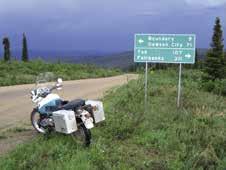 Tom Crafford #82461 Washington, DC
Tom Crafford #82461 Washington, DC
I greatly appreciate the “Postcards from the Road” section of each month’s
magazine. I enjoy seeing how many pictures our members have submitted that are places I have been in my 55 years of riding.
In February’s issue, I recognized my friend’s R 100 RS (Don Wreyford) photographed west of Fort Collins, then immediately said “North Rim of the Grand Canyon,” for Jim Boone’s picture. Gary Loomis’s picture of the West Elks was taken about eight miles from my house!
Nick Greear #87134 Cedaredge, ColoradoEach month, the Rider to Rider pages of BMW Owners News detail the successes, failures, wishes and frustrations we all face as riders, BMW motorcycle owners, customers and individuals. As a BMW MOA member, these are your pages and we want to know what’s on your mind.
Got something to get off your chest? Tell us about it. Know a business that deserves to be recognized? Tell us about it. Got a riding or tech tip that we could all benefit from? Tell us about it. Got a suggestion for BMW Motorrad? You know the drill–Tell us about it! There’s only one rule and that’s to stick to the subject that brings us all here–motorcycling, so save political rants for Facebook! Send your thoughts to editor@bmwmoa.org and lets all work to build a better community.

Fellow MOA members, I am pleased to offer for your consideration, our slate of candidates for the upcoming MOA Board of Director election. All MOA members are entitled to attend our open board meetings and encouraged to participate in online and in-person discussions with other members on our forums, on social media and at our Getaways and National Rally. MOA members are also entitled to vote in our elections for individuals who they feel best represent their interests and vision for the future of the MOA.
BMW MOA board members aren’t only solving problems for today’s MOA members, but setting strategy for the next five to ten years. Someone who joins the MOA in 2030 will be impacted by the decisions we’re making today. New board members are mentored and allowed autonomy to share their opinions, and it’s a healthy and collaborative environment inside of the board.
Our candidates come from different industries, backgrounds and geographies. While there is a lot that separates them, they are all motorcycle riders. We all share this common bond of the joy in traveling on two wheels to the far reaches of the globe. These motorcycle riding MOA members are stepping up to the national stage, throwing their name in the hat and volunteering to serve you. They’re signing up for a board and committee meeting every month, taking time off and traveling to in-person board meetings, open session meetings, and our events including the National Rally to represent the MOA in everything they do. This means riding safely, being respectful to others and leading this club. It’s a big commitment.

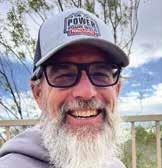
To read full candidate statements please scan the QR code below or visit bmwmoa.org/vote. Additionally, a special Election Forum in the “Clubhouse” at bmwmoa.org will be available for candidates for campaigning, discussing issues and answering questions from the membership. This Election Forum will go live on April 1, 2023, and will be available through April 30. The Election Forum will not be archived and participation by candidates in this forum is optional.
Our last election in 2021 had a voter turnout of just 10%. Having only a couple of thousand members electing our board is not enough. As before, every current MOA member will receive an email with a unique link to cast one ballot in our online voting system. If you are not an email user or prefer to vote with a traditional paper ballot, please contact the MOA membership office and a unique ballot will be sent to you by mail. By voting, you have the chance to help plot the future of the MOA and you can do it in just a few minutes from your phone.
This election would not be possible without our members casting their votes, the candidates who volunteered their services, the election committee who reviewed applicants and brought them to your secretary and the MOA staff who put on this election and will ensure it’s fair and without any chance of double votes or any vote not being counted.
Thank you for voting and thank you to our 2023 candidates for your commitment to our great club.

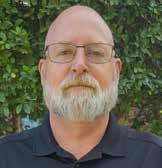
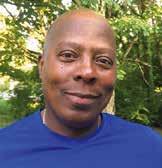
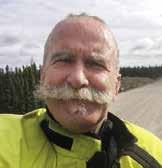


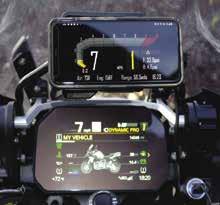 Mike Secor #76153 Plano, Texas
Michiael Shannon #45048 Bloomington, Indiana
Steve Pelletier #154517 Rockport, Maine
Mike Secor #76153 Plano, Texas
Michiael Shannon #45048 Bloomington, Indiana
Steve Pelletier #154517 Rockport, Maine
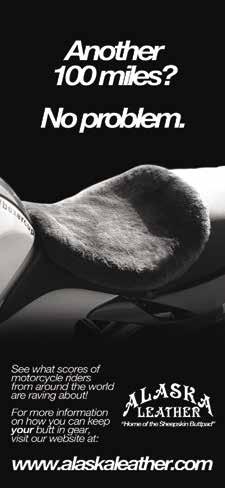


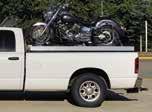








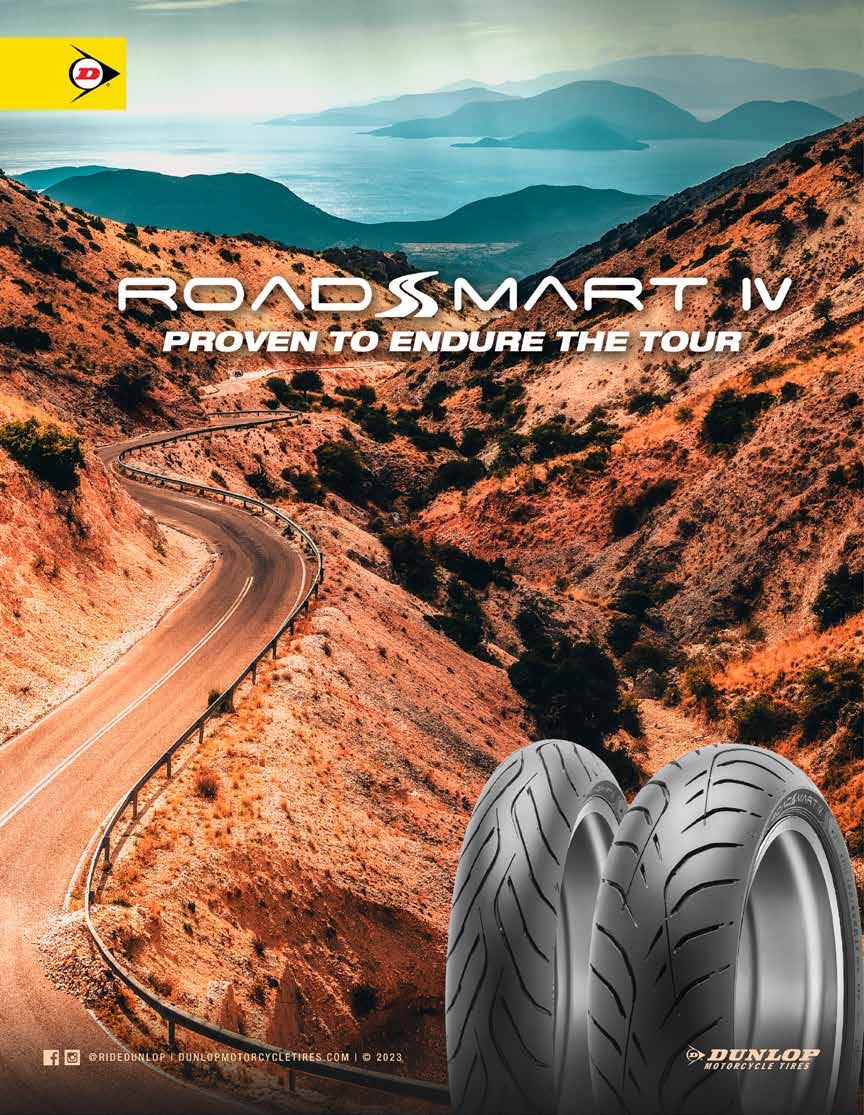

Following the public clamor over BMW Motorrad’s decision to restrict sales of shop manuals for its newest models, the 100-year-old motorcycle manufacturer has now decided to make shop manuals available to new unit owners.
“We recognize, that despite the increasingly complex technology used on our current models, many BMW motorcycle owners prefer to do their own maintenance on their C, F, GS, GSA, RT, R, RS, K and G motorcycles. For that reason, we will now make shop manuals for those bikes available, with a few minor restrictions,” said Motorrad Customer Service Director Hans
Donaudampfschiffahrtsgesellschaftskapitän.
Among those minor restrictions, noted Donaudampfschiffahrtsgesellschaftskapitän, is the requirement to present a notarized BMW Motorrad Master Mechanic Certificate in person at the BMW headquarters in Munich, Germany. Once the certificate from a recognized BMW training facility has been authenticated, applicants will be asked to perform a hands-on skills examination, including the reflashing of software on a 2023 R 1250 GS using only three Krombacher bottle caps, a paper clip and a AAA battery. The three-day examination will also require applicants to change two tires with a GI issue “spork,” smelt and temper a 10mm open-end wrench, change out the drive shaft of a 2023 R nineT in under 15 minutes, and make a simple 6,000-mile valve adjustment on a 2023 R 1800 while blindfolded.
Donaudampfschiffahrtsgesellschaftskapitän also indicated
there will be a slight charge to shop manual purchasers after satisfactorily passing the skills examination of 20 1988 Deutsche Marks (app. $20,000 USD). BMW will not accept cryptocurrency. Failure to satisfy these restrictions and then attempting DYI maintenance, Donaudampfschiffahrtsgesellschaftskapitän explained, would immediately void any model warranty and any opportunity for service at recognized BMW service centers. “Of course, special tracking devices we have integrated into our newest models will also notify our BMW Maintenance Security Team members who will immediately geo-locate the owner, place him under arrest, clear his bank accounts and confiscate his motorcycle,” said Donaudampfschiffahrtsgesellschaftskapitän with a chuckle.

Photos of violators will be posted in plain view at all BMW dealer service desks. BMW Maintenance Security Team officers accompanied by specially trained K-9s will also be authorized to make unannounced visits to the homes of new owners to check for evidence of non-authorized self-service.
BMW motorcycle fans will also be happy to hear the news that shop manuals for BMW Motorrad’s future electric motorcycles will be provided free to any new owner along with the traditional owner’s manual. Leaked galley proofs of service manuals for future E-model BMWs are three pages long, one page each for German, English and Spanish translations, with universal illustrations (see illustrated page sample).
BMW of North America is recalling certain 2023 S 1000 RR motorcycles. The recall, affecting 394 bikes, is to address an issue where the motorcycle hand brake lever may not function correctly, thereby reducing brake performance. To remedy the issue, dealers will replace the hand brake lever fulcrum pin, free of charge. Owner notification letters are expected to be mailed April 18, 2023. Additionally, owners may contact BMW customer service at 1-800-525-7417.
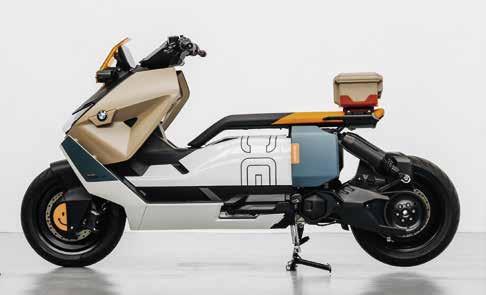
While the international custom scene around BMW Motorrad primarily devotes its creativity, craftsmanship and flow of new ideas to the BMW Motorrad Heritage models R 18 and R nineT, a project based on the BMW CE 04 has taken shape in Austria. In collaboration with BMW Motorrad Austria in Salzburg, custom builder Vagabund Moto GmbH in Graz has created the BMW CE 04 Vagabund Moto Concept–a stylish and multifunctional e-scooter based on the BMW CE 04.
“Everyone defines the mobility of the future in their own individual way. With the BMW CE 04 Vagabund Moto Concept, we now present our own idea of a stylish and multifunctional urban e-scooter that shows just how mobility needs are as individual as each personality,” said Paul Brauchart, founder and managing director of Vagabund Moto GmbH, explaining the philosophy behind BMW CE 04 Vagabund Moto Concept.
Accordingly, this made-in-Austria custom e-scooter not only has a particularly attractive color scheme in white, dark green, beige and black, but it also features various functional elements created in a fresh, modern design style and focuses on a youthful target group. For example, a friendly smiley face not only provides a fascinating visual accentuation on the front wheel hub, it also appears on the glass of the indicator lights. What has remained, however, is
the impressive technical concept of the BMW CE 04 with key data such as 42 hp maximum output, dynamic acceleration of 2.6 seconds from 0 to 31mph, a range of 80 miles and a charging time of just 65 minutes from 0% to 80%–with an optional fast charger at maximum charging current.
“With this custom project, it was very important to us to emphasize the enormous variability of the BMW CE 04. At the same time, it was to be a vehicle that appeals to young, sporty people in an urban environment and still be suitable for every type of customer. The fresh, modern design of the CE 04 is particularly in keeping with its aspiration to a sporty lifestyle,” added Oliver Balzer, head of BMW Motorrad Austria.
In keeping with the motto “Action meets Fashion,” the BMW CE 04 Vagabund Moto Concept was given a functional top case to supplement the standard storage space, along with a surfboard with a transport system integrated in the vehicle–whether for a trip to the sea or to the nearest lake.
“The surfboard isn’t just a piece of sports equipment: it’s also a metaphor for a sustainable urban lifestyle. The BMW CE 04 Vagabund Moto Concept combines work, leisure, and individual flair, demonstrating that there needs to be no contradiction between any of these areas,” concluded Oliver Balzer.
From now until April 30, 2023, buy either a pair or single new Dunlop tire for your motorcycle and save. Purchase a single tire and get up to $25 back. Purchase two tires and get up to $50 back. Purchase two tires with installation and receive up to $100 back when you add any motorcycle service such as oil change, new brake pads or literally anything else! As long as there is a line item on your invoice that clearly shows a serviceable item, it counts! If the installation is included with the price, make sure mount and balance is shown somewhere on the invoice.
For more information or to get your rebate, visit dunlopmotorcycletires.com and click on the PROMOS tab at the top of the page.
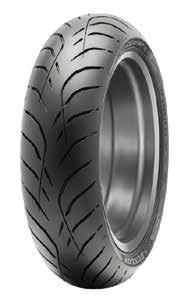
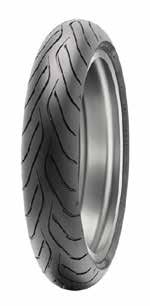
Our 2023 National Rally is so close I can almost see it around the corner! It is time to start refining and finalizing your travel plans, book your hotels and plot your route. We’re ready to hit the open road with the wind in our hair (OK, for those who know me, you know that’s funny right there, as I’m follicly challenged).
This year’s Rally–our 50th–promises to be more fun than a barrel of monkeys. We will have well over 100 exhibitors on site ready to sell you everything you never knew you needed to make your motorcycle adventures better, safer, more comfortable and more enjoyable and to give you the ability to make your adventure precisely what you want it to be. Our Exhibitor Committee is working hard to bring in vendors you have likely never seen but who have products you will wonder how you lived without.
There will be some changes to this year’s Rally, some necessitated by the rally grounds themselves, and a few meant to take a fresh look at how best to represent our membership. The most notable change, mainly due to the rally grounds, will be a change to our Closing Ceremonies and Grand Prize giveaways. Because the rally site does not have a grandstand, we will change things up and have an actual opening ceremony with the presentation of colors on Thursday evening before the entertainment kicks off. Then we’ll split the Grand Prize giveaways across the three nights of entertainment between the bands. You won’t need to be present to win, but we hope you’ll be there as there will be more opportunities for the wonderful people and companies who donate prizes to interact and tell us all about what they are giving away.
Volunteer Appreciation Night will be Wednesday evening and will feature your very own Wes Fleming and his band, 7th Grade Girl Fight. Don’t let the name fool you, Wes’ band is really good, and you’ll be a fool not to be there enjoying a beverage of your choice. Plus, you can make your way through registration before the band kicks off and get that out of the way. This is our special way of saying thanks to everyone who helps bring this party together. As I’ve always said, without our volunteers, there’s no way we could pull this off! Pat yourselves on the back, sit back and enjoy a great band Wednesday evening.
Brewfest is back by popular demand! This year we’ll be featuring several Virginia brews. Please register in advance so we
can hold your place in line, as you don’t want to miss out on some great local beer. I’m not much of a beer drinker, preferring vodka, but Paula and I will be there helping you track which brewery has the best flavor.
For the first time at an MOA Rally, we’ll have a dedicated Overlanding area–a place for our members and friends who travel by something other than a motorcycle or traditional RV–you know who you are. You can register online and pay for a 25’x50’ area to park your rig, and you can have as many tents in your space as you can fit at no additional charge. We’re also planning some fun activities in this area, including nightly bonfires.
For all you adventurous off-road riders, have we got a deal for you!
The 50th will have the ADV Thrill Pit, where you can hone your skills through the offered training. There will be camping around this area just for all those who like to play in the mud, dirt and sand. The ADV Thrill Pit will be the first thing you see when entering the grounds upon your arrival. Even if that type of riding is not your cup of tea, be sure and stop by and see what is going on. It’s sure to be entertaining and well worth the visit.
How about the entertainment? As of the press date, we have contracts out to some awesome bands for our nightly entertainment. As we said, some things will be different, but Lee Harrelson and his stage crew are lining up some of the best musical talent to keep you entertained all week. Expect to see the entertainment lineup in the May issue of the BMW Owners News
Finally, if you‘ve been waiting for a mobile event app for the Rally, we’ve got it for The 50th. We have a brand-new platform that is tops in the event app world, where you can see all the latest rally information, including schedules, seminars, exhibitors and contacts and even make a new friend or two. The ink isn’t quite dry on the software license, but information about how to access the National Rally app will be available at rally. bmwmoa.org as soon as it’s available.
Paula and I are excited to see everyone June 8-10 at the Meadow Event Park in Doswell, Virginia. We’re excited to share our passion for motorcycles and this great organization.
Join us in Virginia and enjoy the 50th National Rally!
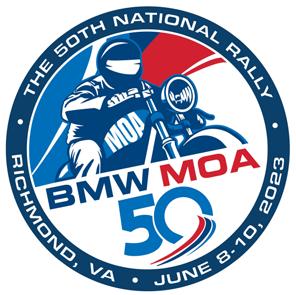
 Riding the beautifully curvy roads outside Spotsylvania, Virginia, north of Richmond.
Riding the beautifully curvy roads outside Spotsylvania, Virginia, north of Richmond.
I’m looking forward to the day when my local roads are choked with BMW motorcycles and the chances of me knowing the riders are high.
My hope is you’ll plan your ride away from the interstate freeways and take the opportunity of travelling to The 50th to explore Virginia. The state is unique in that two of the three major wars which took place in the USA ended in the state: the American Revolution and the U.S. Civil War. Here you’ll find 10 military history sites to visit on your way to or from the Rally, or even as a day trip while you’re at The 50th.
The National D-Day Memorial: Tens of thousands of Allied troops threw themselves out of airplanes or onto the beaches on D-Day (6 June 1944); cemeteries and monuments across northern France memorialize the soldiers fighting for France’s freedom. Bedford, Virginia, hosts the National D-Day Memorial’s life-size display. Tickets are required—see dday.org. Located halfway between Roanoke and Lynchburg, about 160 miles WSW of the Rally site. Set your GPS for 3 Overlord Circle, Bedford.
Yorktown Battlefield: The Battle of Yorktown—really a siege lasting about three weeks—saw the Continental Army (with French reinforcements) trap a larger British force. Blocked from escape by the French navy, General Cornwallis’ force held out for weeks before surrendering to George Washington. Visit the American Revolution Museum (200 Water Street, Yorktown, 23690) and make a whole day of it by also visiting the Jamestown Settlement (2110 Jamestown Road, Williamsburg), the site of the first successful English colony in the New World. Yorktown Battlefield lies about 80 miles SE of the Rally site. Set your GPS for 1000 Colonial National Historical Parkway, Yorktown.
Appomattox Court House
National Historical Park is a living museum–featuring period-correct building restorations– marking the effective end of the Civil War, when Robert E. Lee surrendered to future U.S. president Ulysses S. Grant. Located about 110 miles SW of the Rally site, the town’s American Civil War Museum is just beyond the southern entrance to the park. Set your GPS for 111 National Park Drive, Appomattox, and ride some of Virginia’s prettiest byways to get there.
Richmond National Battlefield Park’s multiple locations cover a wide area memorializing the sprawling Battle of Richmond. Visitor centers are closed on Mondays and Tuesdays, but the parks are open. Set your GPS for the Chimborazo Medical Museum (3215 E Broad St, Richmond), Tredegar Iron Works (500 Tredegar Street) and Fort Harrison (8621 Battlefield Park Road). Nearby Mechanicsville hosts the battlefields of Cold Harbor (5515 Anderson Wright Drive, Mechanicsville) and Gaines’ Mill (6283 Watt House Road).
Fredericksburg & Spotsylvania
National Military Park encompasses four major battle sites and provides an overview of some of the harshest battles of the late Civil War. The park’s locations are 35-50 miles north of the Rally site. Visit all four battlefields: Fredericksburg (1013 Lafayette Boulevard, Fredericksburg), Spotsylvania (9550 Grant Drive, Spotsylvania Courthouse), Chancellorsville (9001 Plank Road, Spotsylvania Courthouse) and Wilderness (35347 Constitution Highway, Orange). If you have time, ride out to where “Stonewall” Jackson’s arm was buried at 36380 Constitution Highway, Locust Grove.
Petersburg National Battlefield:
The nine-month Siege of Petersburg cut off Lee’s supply lines, setting the stage for his surrender at Appomattox. Petersburg was also the site of a critical battle during the American Revolution, and though that battlefield is near this park, it does not have its own park. Located about 60 miles south of the Rally site, you can visit all four principal locations and make it back to the Rally in time for the evening entertainment. Set your GPS to find the Eastern Front Visitor Center (5001 Siege Road, Prince George), Grant’s Headquarters overlooking the

beautiful Appomattox River (1001 Pecan Avenue, Hopewell, Poplar Grove National Cemetery (8005 Vaughan Road, Petersburg) and the Five Forks Battlefield (9840 Courthouse Road, Dinwiddie).
Manassas National Battlefield Park memorializes the Battles of Bull Run (July 1861 and August 1862). The Confederate army emerged victorious both times, but with egregious losses. For an immersive experience, visit the Ben Lomond Historical Site, a tobacco plantation turned wartime hospital, at 10321 Sudley Manor Drive in Manassas. Manassas National Battlefield Park, about 80 miles north of the Rally site, encompasses over 5,000 acres and includes both hiking and driving trails. Set your GPS for 6511 Sudley Road, Manassas.
Bristoe Station Battlefield Heritage Park is near Manassas National Battlefield Park. This county park memorializes the Battle of Kettle Run (August 1862) and the Battle of Bristoe Station (October 1863) and is about 70 miles north of the Rally site. Set your GPS for 11619 Iron Brigade Unit Avenue, Bristow, and go around the traffic circle onto Tenth Alabama Way to enter the park.
Ball’s Bluff Battlefield Regional Park is a state park marking the site of the resounding defeate of George McClellan’s Army of the Potomac. Enjoy guided tours on the weekends and self-guided tours any time; the site includes a national cemetery. Ball’s Bluff is about 115 miles north of the Rally site; set your GPS for Balls Bluff Road NE, Leesburg, 20176.
Sailor’s Creek Battlefield State Park encompasses over 300 acres and memorializes an unqualified victory for the Federal army, one in which Grant’s army captured more than 7,500 Confederate troops—and eight of their generals—and cut off both the Confederate army’s retreat and their supply lines. The park is east of Appomattox, about 80 miles from the Rally site. Set your GPS for 6541 Sayler’s Creek Road, Rice.
For more military history in Virginia, visit rally.bmwmoa.org and check out a longer, more detailed version of this article.
R1250GSA/GS & R1200GS/GSA Sport and Touring

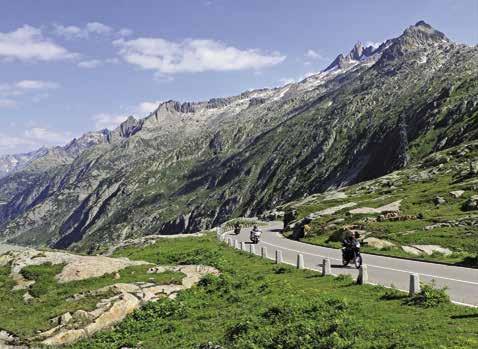
AeroScreens reduce wind noise, turbulence & buffeting. HandFlare Extensions increase helmet and shoulder protection as the screen is raised, reducing noise. HeadLight Covers protect your expensive headlight assembly from damage, breakage or yellowing.

SERVICES:
•
•
•
CONTACT:
•
•
• And all you need
For the motorcycle camper looking for a cooking solution—or if you just want to make coffee to kick off your riding day—check out the camp stoves here. All of these camp stoves except the Firebox are available from our friends at MotoCampNerd.com, who provided information and some photos for this feature. Weights given are without fuel canisters attached.
Jetboil MightyMO
MSRP $59.95
jetboil.com
If you need to simmer anything with a compact stove, this is the stove for you. Everything from Jetboil with "MO" in the name has a built-in regulator for flame control and fuel management. Made in China.
Weight: 3.4 oz
Fuel: Isobutane-propane
Jetboil Flash
MSRP $124.95
jetboil.com

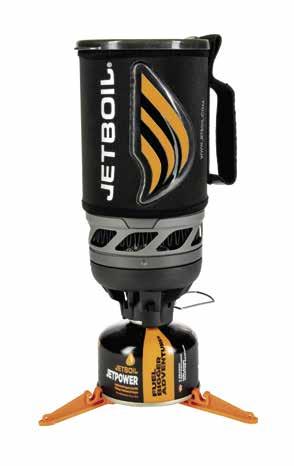
For the rider needing to boil water quickly for coffee and bag camp meals. Beginner friendly! Boils water in just 100 seconds and sports a pushbutton igniter. Made in China.
Weight: 13.1 ounces
Fuel: Isobutane-propane
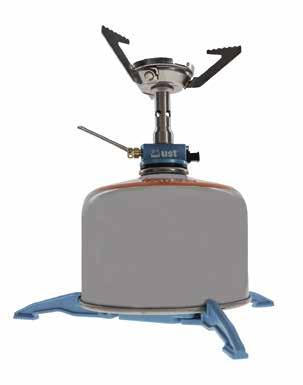
MSRP $37.95
ustgear.com
Aimed at backpackers, the Trekker might be your perfect stove if you prioritize compactness, light weight and ease of use. Beginner friendly, simple and reliable. Made in China.
Weight: 7 oz
Fuel: Isobutane-propane
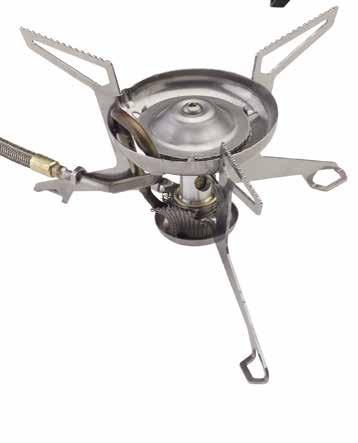
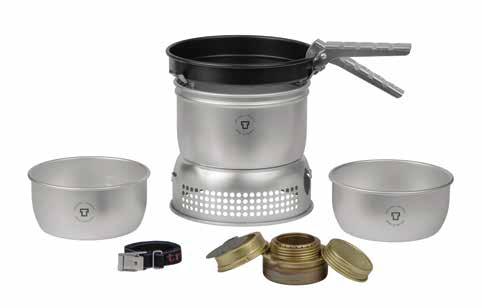
MSRP $199.95
msrgear.com
Are you an overlander or generally want to be able to use more than one type of fuel? Go with the MSR WhisperLite Universal. Best for experienced motocampers rather than beginners. Made in the USA.
Weight: 11.2 oz
Fuel: Isobutane-propane, kerosene, white gas

MSRP $89.99 (27-3 UL kit)
trangia.se/en/
For anybody needing to burn spirits (alcohol) and comfortable making use of the simmer ring to control temperature. Purchase any number of kits (25/large or 27/small) containing the stove with a wind screen, stand, pots and more. Easy to use, but does have a learning curve to ensure safe use of the fuel. Keep in mind the flame is hard to see in daylight, which could result in accidental burns or fires. Made in Sweden.
Weight: 25.6 oz (27-3 UL kit)
Fuel: Spirits (alcohol)
If you don't mind collecting sticks and twigs, the Firebox is for you. Packs flat for easy transport. Beginner friendly as long as you can get the wood burning; can also be used with charcoal briquettes or any other found fuel. Kits and accessories available to aid your cooking experience. Made in the USA.
Weight: 33.3 oz (steel) or 14.6 oz (titanium)
Fuel: Wood
Find these stoves—other than the Firebox—and many other moto-camping supplies at MotoCampNerd.com and check out the MOA's podcast Chasing the Horizon for a discussion with Ben Williams, co-founder/co-owner of MCN.
Hippo Hands and I go way, way back. The original soft vinyl version was created by Craig Vetter of Vetter Fairing fame, and I received a pair to try out as a motorcycle magazine editor in the late 1970s.
Those first Hippo Hands with their cutesy logo were a revelation, extending the riding season–I was living in Chicago then–by months, and this was long before handlebar heaters had come into vogue. I used the original Hippo Hands for many years on many different bikes, eventually selling them in one of those about-to-move-garage-clearing things we often do and regret later.
Riding with the Greater Cincinnati BMW Motorcycle Club (MOA Charter Club #18) these days, the first Sunday of every
month comes with a group ride and some of those mornings are damn frosty! My GSA’s grip heaters help but are not nearly enough when the outside air temp is barely above freezing.
Hippo Hands makes three models: The Alcan, the Rogue (which I purchased) and the Back Country which is more dirt bike/off-road focused. You can read the details on each as well as a good number of user reviews at hippohands.com.
The Alcan is the most expensive at $189 and offers maximum protection against the cold/wet for sport/touring riders. The Rogue is $159 and again is for sport/touring riders and the BMW GS is the target market. The Rogue is best for commuting and will fit most bikes as long as it has handguards–either stock or aftermarket–as they provide the frame for the Hippo Hand’s
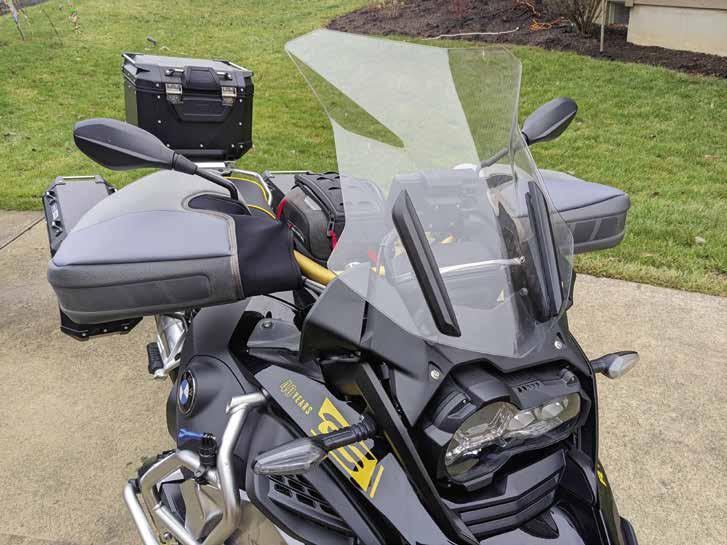
mounting points.
The HippoSkin™ outer cover is waterproof and the soft inner portion is insulated with flexible closed cell foam in a handsome grid pattern. The weather can’t get through to your hands.
As delivered, there are the two, big semi-rigid wedge-y things measuring about 16” wide x 7” thick and several pieces of black foam with wide strips of hook and loop sewn in. The exterior is in not-quite-fifty shades of gray, with big reflective panels on the front. Personally, I’d like to see some more color choices, but that’s just me.
No printed instructions are included and instead, they refer you to the website installation video. Unfortunately, that video is so-so at helping you because it was filmed at too great a distance, so you don’t get any close-ups of the pieces being installed on a Triumph Tiger. By watching the video multiple times and then some trial-and-error test fitting, I got them installed on my 2022 R 1250 GSA.
Summarized, the two rectangular blocks of foam–they have a notch in one side–are secured to the end of the handguards, closest to the grips, where a long hook and loop strap at the end of the Hippo Hand secures it to the handguard. Next, a hook and loop flap goes around the handlebars and mirror, and finally another strap with a section of stretchy neoprene gets wrapped back around the handlebar and pulled tight. Installation is complete.
In turn, the Hippo Hands can be removed in a few seconds by undoing the straps, which can be a bit of a tug-o-war as you’re wrestling with some big, tough hook and loop strips!
Left unexplained in the video are the two extra blocks of hook and loop-covered foam included. These allow you to fine-tune the mounting if needed (I didn’t). These foam blocks can be trimmed or altered to fit your bike just right.



The inside of the Rogue has an attractive stitched grid pattern in orange thread and you have about a 7” wide and 10.5” deep opening for your hands. Unlike some other cold-weather setups, the backs of the Hippo Hands are open; there’s no cinch strap or other obstacle to your hands. Pulling out a hand to adjust glasses or your helmet shield is easy. There’s no clear window in the top, so any of the switches you need to operate are going to be by touch, but after a few miles it’s all instinctive.
I had a chance to do a 100-mile ride with them, and after just a few minutes on a frosty 40-degree Ohio Interstate, I had fallen in love with my Hippo Hands. With the handgrip heater On and wearing lightweight summer gloves, I was toasty warm and comfortable. The Hippo Hands block all of the wind that would usually be working its way up your
The-behind-bars view. Definitely my new choice when the weather is at less than optimum!
sleeves and making you miserable. There’s plenty of room inside the Hippo’s mitts and no difficulty or interference using the switches, throttle or clutch. Your hands are thoroughly protected from the cold, wet, wind and discomfort. No need for bulky winter gauntlets or the plug-in connections of heated gloves. Because your hands stay warm, your whole body feels warmer.
I’ve had them up to fiercely illegal speeds and the Hippos stay rock-solid with no flutter or sense of anything coming loose. Credit the handguards and the thick, semi-rigid HippoSkin™.
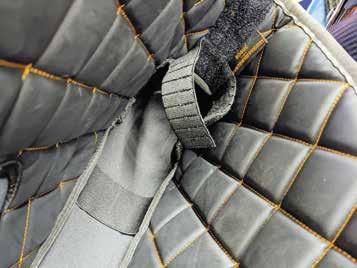
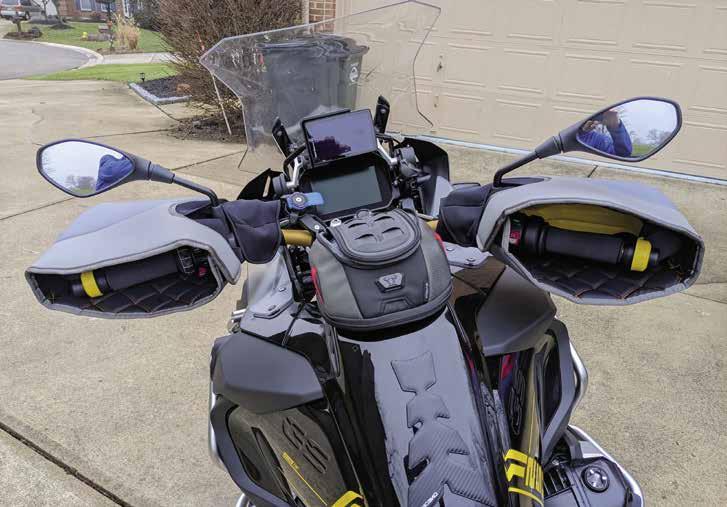
Go to hippohands.com to check them out and purchase. They come with a lifetime guarantee providing a full refund if you ever decide they’re not doing the job.
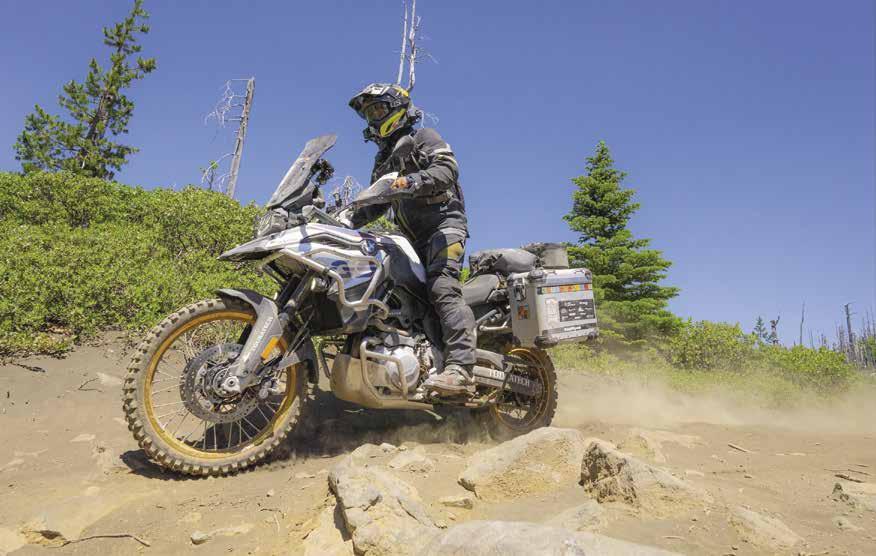
“The Touratech Shock and Extreme Fork Cartridge soaked up the bumps and kept my F850GS controlled and planted on the Oregon BDR.”


Touratech Suspension is valved for adventure riding and has been battle-tested on all 12 BDR routes. It’s earned high marks for performance and reliability over the last decade. Call the Adventure Experts at Touratech: 1(800) 491-2926.


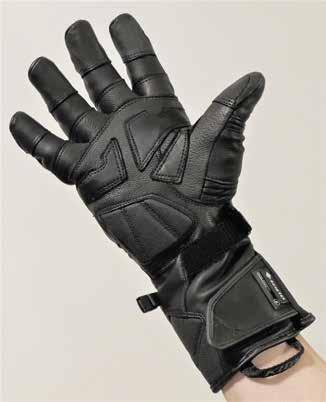
There are ways to ride in reasonable comfort despite fallen mercury. Fairings and windscreens reduce the dramatic impact of wind-chill on the highway. Insulated gear can create an effective bulwark against frigid temps. Electrified clothing and heated grips/seats may augment the warmth generated by our bodies. Unfortunately, some of these benefits typically come with a cost: barriers erected against the cold can also disconnect us from our motorcycles, reducing tactile feedback and rendering control inputs clumsy and awkward.
Nowhere is this more salient and problematic than at the interface between our hands, handgrips and hand-operated controls. Winter riding gloves have the extremely difficult job of shielding our hands–and especially our fingers–from the blast of frosty air assaulting them at speed. Unless our bikes are equipped with handguards or a wide fairing, this may be the most challenging task for any piece of our gear, given the “leading edge” position of our hands and their relative dearth of insulating flesh and fat. Just as our circulatory system helps us shed heat in the summer, it spreads warmth from our core to our extremities in the winter. To conserve warmth, blood vessels constrict near the surface, limiting both the amount of heat lost to the surrounding environment and the amount distributed to nearby tissue. Consequently, our hands are disadvantaged from the inside as well as the outside when we ride in low temperatures.
To stand half a chance of successfully addressing this problem, winter gloves must be constructed with a layer of insulation. While higher-tech synthetics reduce the amount of bulk required for the same level of protection as natural fibers like wool or down, thicker is still better when it comes to staying warm. However, thicker is always worse for agility and tactile sensitivity, so glove makers seek a balance, with any design representing significant compromise. Riders must also choose between imperfect trade-offs, deciding which is the lesser of two evils: losing feel because of a glove’s bulky construction or because of the numbing/stiffening cold it lets through.
On my first few rides this winter, I was frustrated and dismayed by the sacrifices required by my old favorite winter gloves, which were the best I’d been able to find when I bought them several years ago. I went in search of a newer design that might improve my contact with the bike and controls while still keeping my paws from freezing. Given the increasing prevalence of heated grips, I hoped some company might have eliminated the padding on their glove’s underside, which not only separates me from my motorcycle, but also interferes with the transmission of heat from my electrified grips to my needy palms and digits. I found exactly that in Klim’s Badlands GTX Long (gauntlet) Gloves.
I’d bought (and reviewed) a pair of Badlands Aero Pro Short Gloves this past summer. They instantly became my faves for warm weather, allowing copious cooling airflow and extraordinarily supple feel, while still providing good impact and abrasion protection for lightweight kit. Aside from the Badlands moniker and knuckle armor, this cold-weather version shares nothing in common with the Aero Pros. These are very beefy gloves, with a stout leather chassis, wrist cinch-strap, and substantial gauntlet. They feature industry-standard 3M Thinsulate insulation (60g-worth, considered the low end of the “medium” warmth range by its manufacturer), but this layer is only built into the backsides of the hands and fingers. Hence, the gloves deliver good shielding from the cold wind where it’s most needed, while preserving more feel at the bars, levers, and switchgear, and maintaining maximum benefit from heated grips.
“GTX” signifies the presence of a Gore-Tex liner, providing an additional layer of windproofing along with the breathable waterproofing for which this textile has rightfully become the gold standard. The glove-specific version, called “Gore Grip,” features a tight bond between the glove’s layers. This eliminates any internal slipping that would detract from a stable and precise tactile interface. Whereas the inner layer of Gore-Tex will keep a rider’s hands dry, Scotchguard treatment of the exterior
leather and the water-resistant properties of Thinsulate also reduce the rest of the glove’s absorption of water in wet conditions.

One of the most visually striking features of the Badlands GTX Long Gloves is their obvious complexity, with an astonishing number of panels, including segmented articulation of all fingers, accordion-stretch sections on the back of the hand and base of the thumb, index and middle fingers, and a thin synthetic fabric instead of leather on the back and inboard sides of the wrist to reduce gauntlet bulk for ease of wearing them inside a jacket sleeve (the hook and loop-equipped gauntlets are adjustable enough to also fit outside most jacket sleeves). The palms have multiple separate leather overlays, the heel of the hand, outer wrist, and finger backs are covered in padded, flexible ceramic-print armor, and a semi-hard polycarbonate plate protects the knuckles without any uncomfortable impingement or restriction. 3M Scotchlite accents add a bit of visibility, sturdy nylon loops facilitate pulling the gloves on, and the fingertips are equipped with invisible, yet effective, Mult-E-Touch electrostatic screen functionality. Finally, the glove interiors are lined with a layer of luxuriously soft,
moisture-wicking microfleece (thicker on the backside), a neoprene “gasket” helping to guard against water entry at the cuff, and visor wipers of two consistencies (one very firm, the other more flexible) reside on the index fingers. It’s hard to imagine a more elaborately designed, full-featured glove. Klim markets this model for ADV use, and it certainly appears to be rugged enough to deserve that categorization (rated at CE Level 1).
Although they’re a far cry from the slinky variant with which I fell in love last summer, the Badlands GTX Longs really do deliver better feel than any other winter gloves I’ve worn before. While they lack underside insulation, some degree of connection is still lost due to a) the heavily reinforced palms and multi-panel fingers, and b) the backside insulation’s mild resistance to movement and additional girth when maneuvering around control surfaces. Also, when new, the burly leather is a little stiff and must be broken in on a ride or two before achieving its best pliability and fit. I can now enjoy my heated grips sooner and more efficiently, while being shielded from the elements and any impacts far better than I was with my previous gloves. None of my street bikes have wind protection for my hands. I almost
never ride in the 30s, and I used to resign myself to a certain level of misery in the 40s, but these gloves extend those ranges to allow reasonable comfort down to 40F, and they don’t constantly distract and annoy me with disconnected clumsiness, which I personally find abhorrent.

At $249.99, Klim requires a considerable investment to partake of their top-shelf handwear. Depending on the quantity and intensity of your cold-weather riding and the priority you place on dexterity and tactile connection to your bike, these gloves may be well worth their price. They come in solid black, black/light grey, and black/sage, with sizing from small to 3XL; I found the medium consistent with most other gloves I’ve worn.
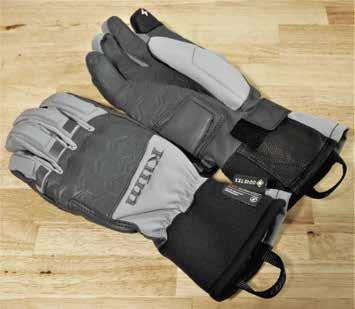

While researching the options, I tried a pair of Klim’s relatively more affordable ($179.95) Vanguard GTX Long Gloves, which sport some of the same basic features, including the enlightened subtraction of underside insulation, Gore Glove breathable wind- and waterproofing, and an equal amount of Thinsulate. Designated a touring glove with much lighter synthetic construction, the Vanguards provide a lot less crash protection. Their neoprene cuffs are very low-profile, making them difficult/impossible to wear on the outside of jacket sleeves, and they didn’t feel quite as warm. Most importantly to me, the Vanguards, despite their geometrically embossed goat leather palms and finger undersides, lacked some of the tactile feel supplied by the Badlands. The Vanguards were also puffier and therefore slightly more awkward when operating levers and switchgear. While the Vanguards would have still been an upgrade from my old winter gloves, I swallowed the Badlands’ additional cost to maximize the improvement. Your priorities may favor the Vanguards.
Note: This shopping experience revealed widespread inventory deficiencies when checking the availability of various gloves at numerous manufacturers’ and retailers’ websites. I stumbled upon Union Garage in NYC, a shop that had in stock both gloves I ultimately chose to examine (along with others I couldn’t find anywhere else) and allowed an easy return of the pair I ranked second place. For more information, visit klim.com/motorcycle and uniongaragenyc.com.



 Klim Badlands Winter gloves inner gasket
Klim Badlands Winter gloves inner gasket

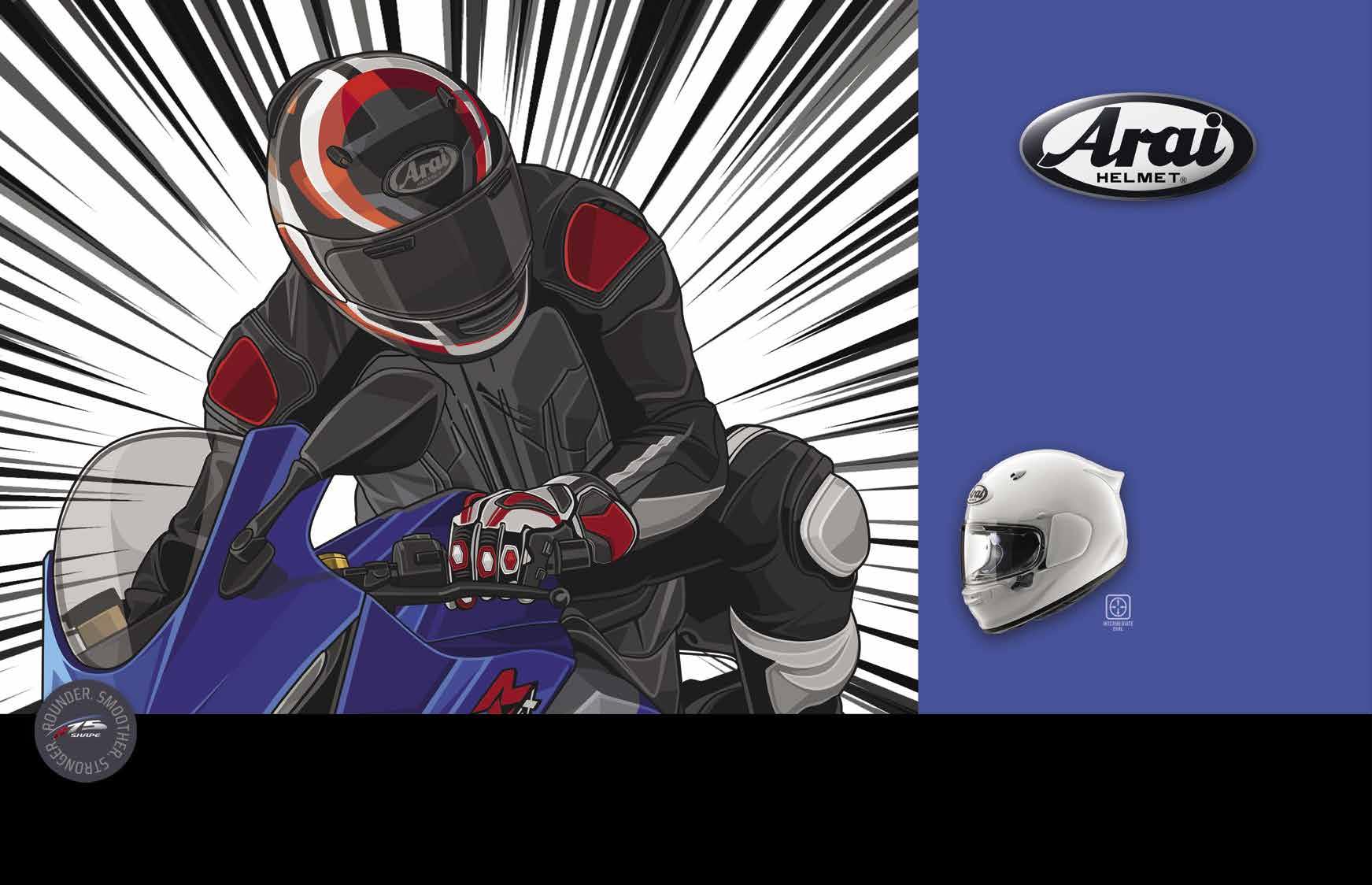

No matter how good a helmet is, the amount of energy that can be absorbed is inherently limited. Faced with an impact that exceeds that limit, Arai’s belief is that avoiding energy by Glancing Off is essential to keeping that energy away from the inside of the helmet.
Arai is still a small, family-owned company driven by the same mission through three generations – three generations of riders. We at Arai are motorcycle enthusiasts. We ride. We build each Arai helmet as if we’re creating it for one of our own – a brother, a father, a husband, a mother, a sister.
Arai’s mission has always been the protection and comfort of every person who chooses an Arai helmet. Our foundational principles of protection first, exceptional quality, and rider comfort have never been forgotten in over six decades of helmet design and manufacturing. This is Arai Helmet.
I’ve received a few emails from folks who were wondering “Where was Matt?” in the February 2023 issue of BMW Owners News. Bill let me know that a few contributors were being “paused” to make room for material in the special “MOA Foundation Issue.” As I was in my usual winter slowdown, along with having heart and back pain problems, I was OK with a month off. Now, I’m feeling somewhat better, and I’ve seen a bit of work with the Airheads. I’ve also fielded a few phone calls from people wondering about some aspect of the bike they have. I do enjoy helping folks sort out issues that they are not familiar with.
The February issue of the Owners News had a Letter to the Editor asking about my account of a R 90/6 that came to me with “some sort of horrible noise” in the driveline. I really didn’t share the end of that tale. Troubleshooting indicated the problem was not in the engine, due to failing bearings or some other issue. The next step was to get into the driveline, looking for something that was amiss. As I pulled down the clutch and throw-out system, there weren’t any real problems noticed. The throw-out system was out of adjustment and the clutch was dirty but well within tolerance. The bike owner and I opened up the transmission and found a couple of areas that would benefit from attention, but nothing that was dramatically wrong.
Basically, I cleaned all parts up, burnished a couple of points showing wear, lubricated a couple of points of contact and put everything back together. As I noted in the column, when the bike was fired up, it ran with a nice, gentle idle. So, no major breakdown. Rather, it was a long-running Airhead that was overdue for a good going over.
In the last few weeks, I’ve rebuilt a couple of gearboxes. One came to me from the Midwest, via FedEx, with a visibly worn input shaft. The splines were clearly missing quite a bit of material and had been in a failure of the clutch, which stripped. I replaced the input shaft with a good, used one, checked over the rest of the innards and replaced the output shaft “big bearing,” which was loose and kind of rough. The “inner bearing’” of the output shaft gets the lion’s share of the internal stress within the transmission. For that reason, it’s a bigger ball bearing than the other five bearings and has a sheet metal “trough” to channel extra gear oil to it when in operation. Usually, when a five-speed transmission fails, the problem starts with that bearing. If you are looking at a gearbox that shows cracking around the output flange area, its because the big bearing has failed, allowing the shaft to wobble. If not caught early, this moving shaft will damage other gears and bearings. While this gearbox was a rather high-mileage unit, the other bearings, when cleaned of oil, proved to be smooth and tight.
These are three different versions of airhead gearbox output seals. The green one is the older style, found in transmissions on bikes with oil-filled swingarms/driveshafts. The center one is the newer version, introduced.to be used with the GS type of airhead. These bikes run with a "dry" swingarm. Finally, the right-hand seal is a "dual lip" seal I sourced from a seal/bearing supplier. A couple of places refer to these as "Polaris" seals. They are the same dimensions as the other BMW seals and seem to do better as far as keeping the gear oil in the transmission.
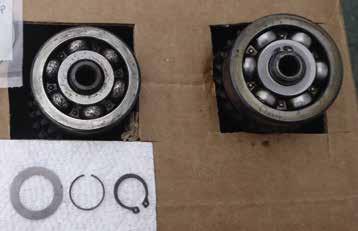
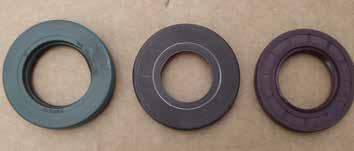
About a week ago, I received a call from a local rider on a ’78 R 100/7. He was stuck in second gear. After my asking about the shifter, he reported it was securely fastened to the transmission. I’ve seen a few transmissions with the 6mm bolt, that anchors the shifter, loosen up. The loose shifter doesn’t allow the rider to change gears. A very easy repair but, unfortunately, this was not the case with this bike. The problem was inside the gearbox, in the form of a broken detent spring.
Since this was a fairly low mileage bike, I expected the internals to be in pretty good shape. In six and a half hours, I got the tranny out, apart, repaired and back in the R 100/7, along with a renewed clutch plate. The detent
was indeed broken–the $2.50
spring that caused all this was replaced. I then replaced the plastic detent roller with a small ball bearing of the same dimensions. The bearings were cleaned and checked. All were in decent shape.


On the test ride, the bike shifted very nicely at slow, neighborhood speeds. Usually, when a gearbox is opened up and worked on, it runs noticeably better when returned to the bike. Cleaning out dirt and sludge, polishing the tubes the shifters slide on, updating the shifting cassette with that ball bearing roller, cleaning and lubing the throw-out system and re-shimming the three gear clusters almost always improves the “action.” Even without any problem, the gear clusters change their shimming requirement as the bearings settle in.
I’ve appreciated the slow winter months. I’m definitely slowing down. Between heart issues, the polymyalgia rheumatica and old injuries, my endurance is not what it once was. I still haven’t decided about what to do with our Europe bikes and my Mexico bike. We’ll see how I feel once things warm up a bit, but after 50 years of over-the-road riding, my time may be done. Susanna is contemplating the same. Happens to us all.
I know the “oldest rider” prize usually goes to someone in their eighties, but those folks are essentially outliers. My friend Harry and I are the remaining riders in the eight-man Men’s Group I helped start in the ‘70s. As I’ve mentioned before, at one time, seven of the eight of us were riding airhead BMWs. I was a good influence, I guess.
Matt acquired his first BMW in 1972, upon his return from Vietnam. He hired on at Doc’s BMW of Colorado Springs in 1977. Since then, his life has been a mixture of travel, owning/working in various shops, as a nurse, and being very involved in his local community. He has owned around 15 Airhead BMWs over the years, but his first bike, a 1972 R 75/5, is parked by the front door with 423,000 miles on the odometer.
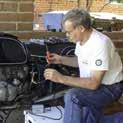 This is the shifting cassette from the gearbox suffering from a broken detent spring. The detent roller has gone through a few different versions.
Whenever I have a five-speed transmission opened up, I polish the two posts the shifting forks ride on. The posts are made of steel and they often show a bit of rust or corrosion. I use very fine emery cloth to remove anything that could interfere with the smooth sliding of the forks. It just happened that this gearbox had a tiny nick in the post with the pair of forks. The nick was significant enough to cause the fork to operate in a rough manner. A few minutes with fine emery cloth had the forks sliding on the post nice and smooth.
MATT PARKHOUSE #13272
This is the shifting cassette from the gearbox suffering from a broken detent spring. The detent roller has gone through a few different versions.
Whenever I have a five-speed transmission opened up, I polish the two posts the shifting forks ride on. The posts are made of steel and they often show a bit of rust or corrosion. I use very fine emery cloth to remove anything that could interfere with the smooth sliding of the forks. It just happened that this gearbox had a tiny nick in the post with the pair of forks. The nick was significant enough to cause the fork to operate in a rough manner. A few minutes with fine emery cloth had the forks sliding on the post nice and smooth.
MATT PARKHOUSE #13272
A(ish): We all know social media is a great place to express our offensitivity—a word I made up to describe getting super upset over something which wouldn’t upset most people and then griping about it online because otherwise nobody knows how angry you are.
The social media post above was made by somebody who is not an MOA member in response to a video posted by an aftermarket suspension manufacturer, who made a number of dubious claims in the video about how poor the stock suspension on a new, presumably expensive, bike is, including calling the stock suspension components low quality with poor spring rates. They continued by claiming stock suspension components “don’t work as advertised,” lack adjustability, are “stiff” and “fully extended all the time,” are “one size fits all,” and cost about $15.
They went on to tout how their suspension components are none of those things and are the best thing since Betty White—which of course they would do. Their job as a manufacturer of aftermarket parts and accessories is to convince you your bike exists in an unacceptable state as you bought it, because otherwise you won’t be desperate to improve the performance of your motorcycle enough to buy their products.
Motorcycle suspensions have come a long way in the past decades, and I’m
comfortable saying they’ve come far enough that replacing especially your rear shocks is no longer necessary the minute you get home from the dealership with your brand-new bike. Some aftermarket manufacturers can, will and are obviously continuing to play on long-held stereotypes and prejudices against OEM suspensions, but that doesn’t mean we can’t glean some nuggets of improvement from them when we consider the suspensions on our own bikes.
As with nearly everything else on any motorcycle made by any company, the manufacturer is trying to get the most performance at the lowest cost, which means components not manufactured in-house are often made by the lowest bidder willing to comply with the engineering specs.
There are pros and cons to replacing your suspension, but unless you’re operating your motorcycle at the edges of its capabilities (and yours)—such as heavy off-road riding, extended heavy two-up touring, competitive racing, etc.—there’s no reason to preemptively replace your suspension as soon as you get your bike. Once that stock suspension has 40 or 50,000 miles on it though, it might be time to consider an update or upgrade.
One thing many aftermarket shocks provide which OEM ones do not is the capacity to rebuild, repair or upgrade
them without fully replacing them. This means that when they eventually wear out—and all suspension components do eventually wear out—you can have them rebuilt to like-new specs and save some money along the way. If something breaks on them, you can typically repair them instead of replacing them like you would with standard OEM shocks.
Aftermarket suspensions often provide superior performance compared to stock components, and can provide better handling, improved stability and a more comfortable ride. Since you can select components specific to your needs, you get shocks for you and your ride, rather than the OEM one-size-fits-all parts. Aftermarket components can also be built to higher standards, which means they can last longer—depending on the application—and bring in the capacity to rebuild or adjust them at a later date. While we might argue about the used value of your motorcycle overall, few of us can deny that seeing a used bike with Öhlins, Touratech, WP, Tractive, Wilbers or Wunderlich aftermarket components with a slightly too-high asking price doesn’t bring as much of a pause as some other add-ons might.
There are downsides as well, starting with the cost. Aftermarket suspension components are quite often expensive to the point of excess, even when we know their benefits. Depending on whether you’re replacing the entire shock or just the
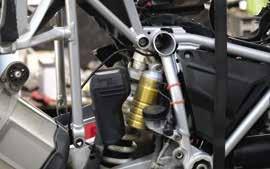
Q(ish): So let me get this straight— I drop 30 to 40K on a motorcycle and I “HAVE TO” upgrade the suspension?"
–Social Media Post
spring, you might need specialized tools for the installation; if you’re unwilling to spring for those tools, you’re stuck paying somebody else to do the work, adding even more to the expense. In some cases, altering your bike’s suspension could void its warranty, which is the #1 reason I recommend keeping your OEM shocks in place at least until your warranty expires. Finally, for some of us, aftermarket suspensions are simply overkill—despite how we think we ride, we simply do not ride in a fashion which can benefit greatly from costly suspension upgrades.
In the end, upgrading your suspension depends on your needs, preferences, riding style and skill level. A serious rider looking for improved performance, customized parts and rebuild-ability will likely find suspension upgrades a worthwhile investment. Casual riders, including folks who primarily commute on their motorcycles, may find the cost and complexity may not be worthwhile.
And we haven’t even gotten into what goes into properly configuring your fancy, expensive aftermarket suspension!
Visit the MOA’s YouTube channel (bmwmoa.club/YouTube) to see what goes into upgrading the stock springs on a 2015 R 1200 GS along with a bunch of other tech-related videos.
Inn of the Ozarks

207 W. Van Buren

Wherever
Each
Relax. Ride. Refuel.
• Relax knowing your bike is safe and secure.

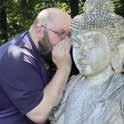
• Ride the challenging byways of Eureka Springs.

• Refuel with a delicious meal at Myrtie Mae’s Cafe.
Wes Fleming tried being a rock star for 25 years, but gave all that up to focus on motorcycles. His mother still hasn’t forgiven him. The first new motorcycle he ever bought got run over by a car – with him still in the saddle. He discovered BMWs thanks to a friend in 2001 and has been riding trendy, not-so-trendy and sidecar-equipped BMWs ever since. Wes currently holds down multiple jobs, including freelance guitar consultant and history professor; when he's not pacing around his empty nest, he's out looking for a great deal on a used motorcycle.
Liqui‐Molyoil ‐ oil, fuel & air filters – 12/24K maintenance kits – brake pads & rotors – fuel pumps – Hall sensors – repair manuals & dvds–tools – fuel line disconnect sets – fuel injection controllers – exhausts – batteries & chargers –master cylinders & rebuild kits – starters – spark plugs & wires – cables – radiator fans – alt belts – fender extenders – Carbtune carb/TB synchronizers
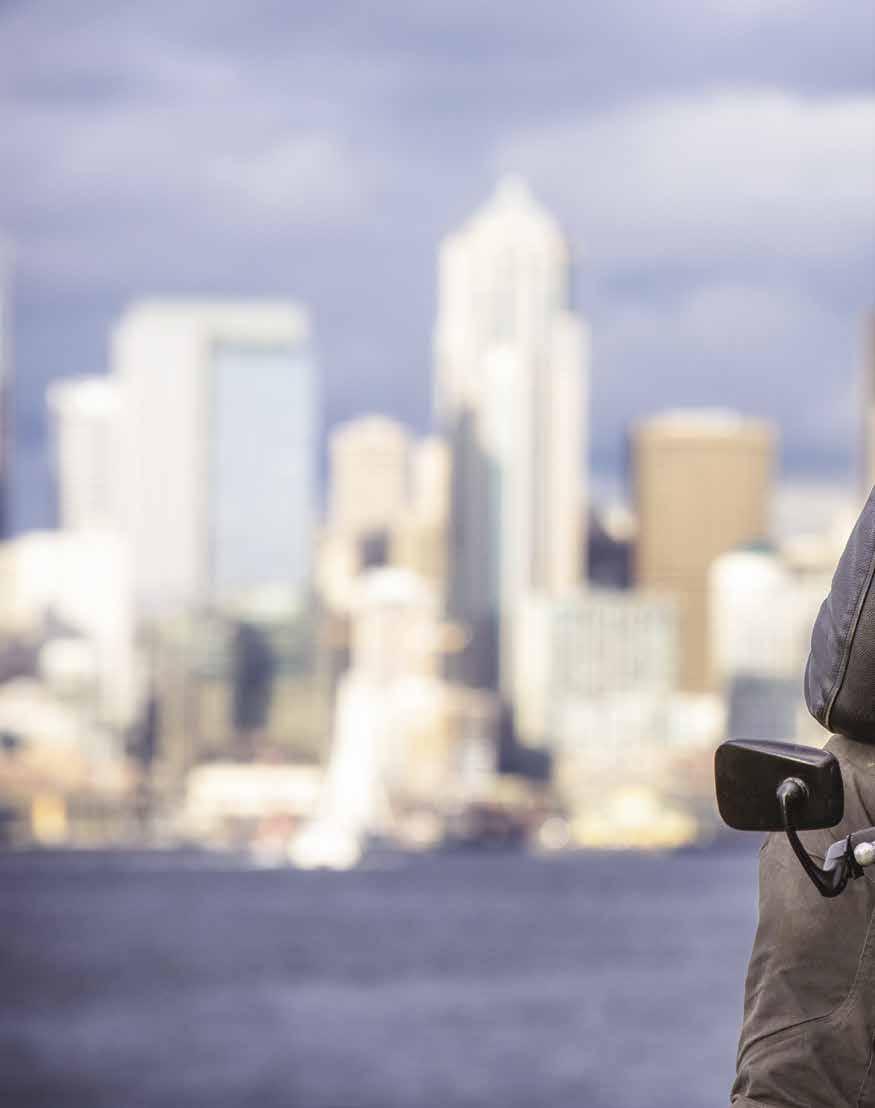 By Charlie Rubin #207892
Sterling Noren poses on his BMW R 50/5 with the Seattle skyline as the backdrop.
By Charlie Rubin #207892
Sterling Noren poses on his BMW R 50/5 with the Seattle skyline as the backdrop.

They say that if you earn a living doing what you love, you’ll never work a day in your life. Filmmaker Sterling Noren (#92900) embodies that credo, having combined his video production skills, a passion for backroad and adventure motorcycling and a keen sense of opportunity to create a successful filmmaking career. For the past 30 years, he’s ridden BMWs and filmed in more than 60 countries.
Noren grew up on a blueberry farm on the shore of Lake Michigan. His mother and aunt got him his first motorcycle in 1978 for his birthday when he was only eight years old. He road that Honda Trail 50 over the dirt roads and backroads in his area, and then upgraded to a Yamaha 360 Enduro when he was 12. His next motorcycling experience wouldn’t be until 12 years later, when he moved to Seattle in 1994 and bought a 1972 BMW R 50/5.
“For the most part, I’ve been on BMWs ever since,” Noren says. “I rode that R 50 for four years, and bought an F 650 GS Funduro, the first chain-drive BMW. It was a GS, so I could go off road more easily, and it was also affordable.”

Noren rode the Funduro for 12 years and has subsequently owned an F 800 GS and a 1200 GS Rallye–both of which have come in exchange for filmmaking work for BMW Corporate.
Noren knew he wanted to make films when he was still a teenager, and he went to school for film and video production while still living in Michigan. After moving to Seattle and making corporate videos for Microsoft for four years, he was laid off. It was time to strike out on his own.
“I knew I wanted to make films, and the subject that most appealed to me was motorcycling,” he says. “I saw a slide show by Helge Pedersen as he described his 10 Years on 2 Wheels book project in 1998. That really opened my eyes to global motorcycle adventure touring.”
At the slide show, Noren approached Pedersen and suggested that he ride with him and make videos about their experiences. They started with a short project where they rode and camped around Washington State for a few days, and Noren made a 10-minute documentary that was aired on the local public television station.
In 2000, Helge Pedersen started his international motorcycle touring company, GlobeRiders, where he takes people on tours for 60-70 days at a time. He asked Noren to come along on some of those tours and film them, and for the next ten years, Noren filmed with Pedersen in over 60 countries around the world, producing not only videos for GlobeRiders, but also turning half a dozen of them into documentaries for the Discovery Channel.
Through his experience with GlobeRiders, Noren learned about the challenges of filming touring groups in the wild. “Sometimes it was a little difficult because although they were all great people, the riders on the tours were on vacation–they weren’t there to make a movie. My needs didn’t always sync with their needs; I’d want to spend hours filming and trying to get the right shot, and they wanted to head on down the road.”
He also had to deal with legacy film technology.
“When I started making riding videos, there were no drones or helmet cameras; every shot was, ‘Stop the bike, set up the tripod, ride, and then go back and pick up the camera and
tripod.’ I used to have to carry a 12-pound tripod and a six-pound camera. Now, I can carry two cameras and batteries in a small case.”
In 2009, Noren was finishing up his work with GlobeRiders, and it was time to really head out on his own, riding the roads he wanted to explore and filming along the way. The following year, he and a group of like-minded riders started Backcountry Discovery Routes, a non-profit organization that creates and preserves offroad riding opportunities across the US. Since then, BDR has released GPS tracks, maps and videos of offroad riding in a dozen U.S. locales, including the West, Northeast and Mid-Atlantic, as well as some individual states.
Noren also started “The Motorcycle Travel Channel” on YouTube, where he hosts videos about his solo rides in North and South America along with other videos of GlobeRiders
tours and films he’s done for BMW, including a three-part history of the GS. In fact, he’s hoping to do another film for BMW’s 100-year celebration. “My 1200 GS has 60,000 miles on it now and it’d be nice to upgrade,” he says.
As his first big solo ride in 2010, Noren wanted to do a story about Mexico, but he wasn’t sure what the subject would be. Setting out from Seattle on his 650 Funduro, he rode down the length of Baja, took a ferry to the mainland, and then rode through Copper Canyon, the deepest gorge in North America.

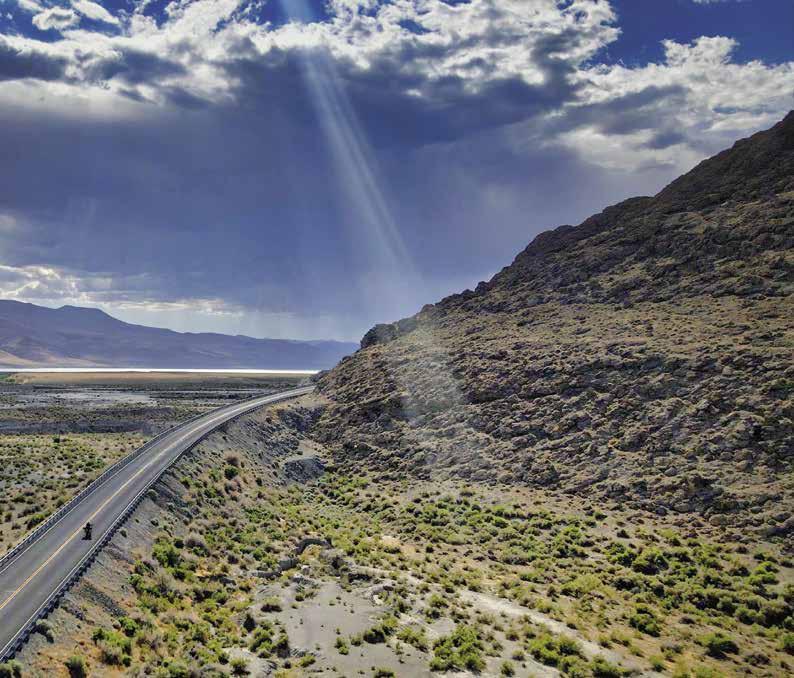

After 40-odd days on the road in Mexico, however, he still hadn’t yet found the right story, but at the bottom of Copper Canyon, he met the Tarahumara Indians living there. “They’re some of the best runners in the world,” Noren recalls. “They run with Huarache sandals across the canyon. The only other gringo down there was Micah True, a hippie from Colorado who was an ultra-marathon runner. Micah was setting up a race pitting the best ultra-marathoners in the world against the best Tarahumara runners. I filmed that race, and it turned out to be the story I was looking for.”
Soon after he filmed the Tarahumara race in Copper Canyon, Christopher McDougall’s book Born to Run: A Hidden Tribe, Superathletes, and the Greatest Race the World Has Never Seen came out, featuring the story of the tribe, Micah True and the race. The book was a bestseller, and Noren headed back down to Copper Canyon to do a full documentary about Micah True.
“A week after I finished filming,” Noren says, “Micah was out trail running in New Mexico and he disappeared. I realized that I had the only video interview he had done, and people wanted to know more about this guy who was the subject of Christopher McDougall’s book, so I released a movie called Run Free: The True Story of Playa Blanca, in 2016.
Today, Noren lives in Bisbee, Arizona. When he’s not out riding, he and his partner Eva own and operate Bisbee’s Jonquil Motel, a historic inn that caters to motorcyclists with ride maps and local dining and sightseeing recommendations. His latest project is Riding Solo - AZ to BC, a film about his 53-day ride from Arizona to British Columbia on backroads. But if you don’t run into Sterling in Bisbee, you may see him on a backroad somewhere else, wherever that happens to be.
Learn more about Noren and his adventures in filmmaking by listening to Episode 45 of Chasing the Horizon (horizon.bmwmoa.org/episode-45-sterling-noren/).
Charlie Rubin has been writing professionally for 40 years, mostly about computer and communications network technologies, although occasionally about motorcycles.

He began riding seriously in 1990 and has owned and collected more than 40 motorcycles, a dozen of them BMWs, and has ridden from his home in Southern California throughout the west as well as crosscountry to Toronto, and in Germany, Austria, Switzerland and Italy. He currently rides an R 1250 RS.
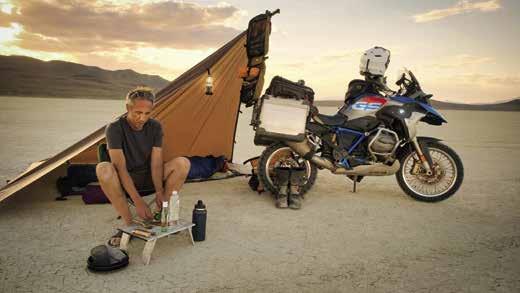
 Left, A drone shot captures Sterling amid the vastness of the southwest. Above, Setting up camp for the night while on the road.
Left, A drone shot captures Sterling amid the vastness of the southwest. Above, Setting up camp for the night while on the road.


















INTELLIGENT MULTIFUNCTION LED LIGHTS FOR BMW BIKES





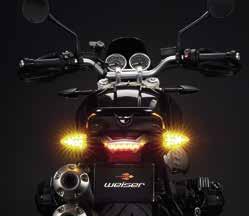





















SINGLE FUNCTION TURN SIGNALS






DUAL FUNCTION FRONT DRIVING LIGHTS/TURN SIGNALS



TRIPLE FUNCTION REAR RUNNING TURN SIGNALS
Hazard Lights



RUNNING/BRAKE LIGHTS/TURN
Running Lights

Brake Lights

Hazard Lights





Running Lights

































Brake Lights
VERY LATEST, HIGH INTENSITY OSRAM AUTOMOTIVE LED’S EMITTING CLASS LEADING 120 DEGREES OF VISIBLE LIGHT. (LENS DIFFUSED TO 180 DEGREES)










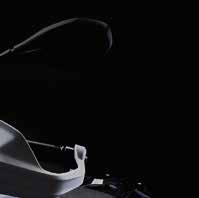


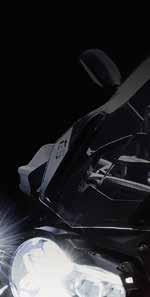
Weiser’s updated EVO range of LED lights add dynamic multi-functionality to your bike’s turn signals in a stunningly effective package. Designed to help get your motorcycle seen... whatever the maneuver...whatever the weather conditions.
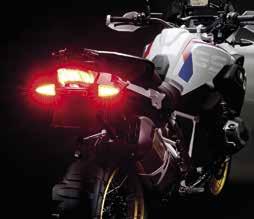


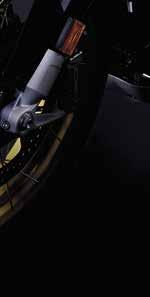
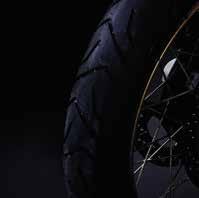

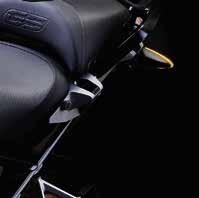
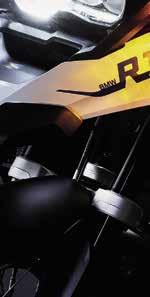
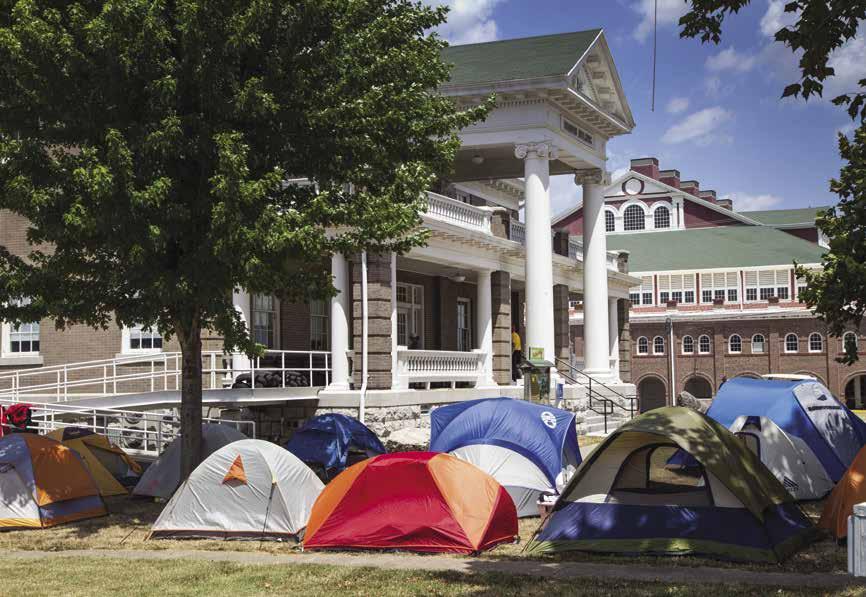 BY ALAN TONEY #124362
BY ALAN TONEY #124362
At seven stories tall, the Hotel Bothwell dominated the downtown skyline of Sedalia, Missouri, the host city for the 2012 BMW MOA National Rally. It was Day Two, and the choices for lunch at the various eateries on the Missouri State Fairground were starting to pale: hot dogs, hamburgers, steak ‘n fries, BBQ, corn dogs and the ubiquitous funnel cakes. “None of the above, thank you,” I said to myself and whoever was in earshot. Perhaps there was a regional specialty offered close by?

Google revealed that, at the Wheel Inn on Route 65S, they offered Sedalia’s claim to culinary fame, the “Goober Burger,” a beef patty, lettuce, tomato and onion, slathered with a huge gob of peanut butter as featured on Man vs. Food. The Goober Burger won.
Undaunted, I climbed on my R 1200 GS for the short ride into downtown Sedalia in search of lighter fare. Where better, I thought, than at the Hotel Bothwell, that American revivalist architectural gem on the corner of 4th Street and South Ohio Avenue, where they offered lunches with style and flair and traditional value in their Ivory Grill just off the lobby. How about gazpacho-style Chilled Cantaloupe and Watermelon Soup, followed by Chilled Teriyaki Salmon on a bed of Chef’s Salad featuring fruits and vegetables from the Chef’s garden? “Brilliant!” I thought to myself so as not to disturb the other diners. “What an excellent pairing of textures and tastes, chilly enough to act as a double counterfoil to the 105 Fahrenheit degrees that lurked outside.”
While waiting for lunch, I thumbed idly through the Things to See and Do in Sedalia magazine and came across a fascinating Bothwell factoid: “Harry S. Truman, Bette Davis and Clint Eastwood once stayed here.” Well, not on the same night nor in the same bed. Separately, you understand. Harry S. and Betty D. did not perk my interest, but Clint did. But why Sedalia, of all places?
For the answer, more page turning revealed a Sedalia with a colorful past, with a heyday in the ‘60s–the 1860s, that is. The Missouri Pacific Railroad was pushing steel westwards from St. Louis to Kansas City when, in 1861, it was rudely interrupted by the Civil War. Sedalia, therefore, became the accidental railhead for Texas longhorns driven up from San Antonio, bound for the meat packing houses of St. Louis and Chicago. However, the cattle boom was short-lived, as the railway resumed its westward push after the war to establish railheads in Abilene, Wichita and Dodge City.
The economics of a cattle drive were simple enough. Cattle on the hoof in Texas were worth $3-4 per head and ten times more in Chicago. Typical herds numbered around 3,000 head, pooled from twenty or so different owners, driven by 25 cowboys who earned a dollar a day and all they could eat. The bottom line? It cost about $1 per head to drive the herd to the trailhead in Sedalia. You do the math. I can’t. But where I wondered, did Clint figure in all this?
A diner at the next table provided me with the answer. “Gladys” (not her real name) was a junior at Sedalia High School in 1958 when it was announced that special guests were coming to town and a parade was planned. Gladys was a cheerleader, and her boyfriend played trumpet in the marching band, so they both got the day off school to march up South Ohio Avenue for speeches and photographs opposite the Hotel Bothwell on the Court House lawn.
Gladys reflected, “At the back of the parade, there were these two guys on horses. We didn’t know them from Adam; unknowns at the time, they later turned out to be Eric Fleming and Clint Eastwood. I suppose they put them at the back so we didn’t have to march through all that horse poop. They were in town to promote an upcoming TV series about life on the Sedalia Trail. They called it Rawhide. We used to watch it every Friday night on CBS. It was “our show” but it took them the longest time on the series to reach our town. I still remember the words to Frankie Laine’s opening theme song: “Head ‘em up, move ‘em out, Rawhide!” You know the one.
Gladys was right. The series ran for 217 black and white episodes over eight seasons, outrun only by Gunsmoke, Bonanza, The Virginian, and Wagon Train. Eric Fleming played trail boss Gil Favor opposite Clint Eastwood as ramrod Rowdy Yates, with Sheb Wooley as scout Pete Nolan and Paul Brinegar as Wishbone, the irascible cook. In only a handful of episodes, the cattle drive reached Sedalia, instead dealing with “incidents” and “issues” along the trail. When it finally arrived (episode 67), they faithfully reproduced Sedalia circa 1866, complete with the dogleg in South Ohio Avenue just 1/4 mile from the stockyards and the railhead, albeit on a studio lot in California.
Before Rawhide, Clint had had only bit parts, and walk-ons in such forgettable movies as Francis Joins the Navy, appearing as Jonesy, second banana to Francis the Talking Mule, and as “first Saxon” with stars Maureen O’Hara and Victor McLaglen in Lady
Godiva of Coventry. Rawhide (1959-1966) launched Clint into a career without equal. In that series, he learned his craft as both actor and director, leaping from the small to the big screen as “the man with no name” in the Sergio Leone trilogy. After that, he never looked back. And he never returned to Sedalia after the parade in 1958.

“So where are the statues to Rawhide and Clint, the Sedalia Trail, and all those 260,000 longhorns that passed through this town?” I asked Gladys over coffee.
“There’s a wall plaque down at the Old Katy Railroad Depot about the cattle drives that gives a passing mention to Clint, but no one knows what room he stayed in at the hotel,” rued Gladys. “It’s just that some of us still remember that day. They were both so nice, Clint and Eric. Real gentlemen they were. I got my picture taken with both of them after the parade. I still have it at home. It wasn’t easy to get all three of us in the same photo as they were both’6 4” and I was only 5’ nothing.”
I looked across the table at this 70-something, perfectly groomed, blue-rinse-haired lady as she repeated wistfully, “Yes, I was a junior in high school when Clint came to town way back when. But overall, it’s been a mostly quiet life here in Sedalia, and we like it that way. We just have the Missouri State Fair every August and that’s predictable. It’s been a quiet life, except for that awful thing that happened in 1974!” Gladys rolled her eyes and looked away. I knew there was more to this story.
“What could she have meant?” I pondered as I hurried back to the rally for a full slate of afternoon seminars and workshops.
Curiosity sated, and my brain replete with new knowledge, it was then time to chill in my folding chair with a cold one at the Beer Garden Grandstand music venue. A special treat that night, John McCuen and Sons opened the show. Pop McC was, of course, none other than that multi-talented instrumentalist and erstwhile Nitty Gritty Dirt Band member.
John Senior dazzled the smallish (1,000 people or so) audience with his wizardry on banjo, fiddle, mandolin and steel guitar, telling stories honed over 40 years. He ran the gamut of NGDB classics, interspersed with the next generation of McCuen magic, sons Nathan and Jonathan, musicians and singer/songwriters in their own right. Sometime during the set,
John mentioned his last appearance at the Missouri State Fairground, when he had played to a”‘slightly larger” audience at the Sedalia Ozark Music Festival in 1974.
John McC uttered three basic truths (1) if you weren’t at Sedalia ‘74, the locals will try to tell you that it never really happened; (2) if you remember Sedalia ‘74 you couldn’t possibly have been there, because (3) if you were at Sedalia ‘74, you couldn’t possibly have remembered anything. Intrigued, it was Google time again for the background skinny, then back to lunch at the Hotel Bothwell the following day to fill in the details with some local color on “the concert that never was.”
Impeccably groomed, 70-something Gladys was again eating lunch at the same table, this time with her sister, Edith, and both were ready to spill the beans on Sedalia’s darkest moment. Gladys took a deep breath and began.
“It all started innocently enough with an application for a permit to hold a small bluegrass Ozark folk music concert, 5,000 people or so, at the State Fairground. Well, we’re all bluegrass fans in this town. After all, we live right next door to Kentucky, so we all bought tickets. Besides, we have a rich musical heritage in these parts; we have the Scott Joplin International Ragtime Music Festival on the streets every June. Scott is our adopted son, you know. He may have been born in Texas and raised in Texarkana, but he spent two significant periods of his life in Sedalia. Here, in this very hotel, he wrote his charttopping ‘Maple Leaf Rag.’"
“But where was I? Oh yes, before we knew it, our little bluegrass concert had grown like Topsy. It was advertised in a full-page spread in Rolling Stone magazine and suddenly went viral.’ I think that’s the term they use nowadays. They came from all over, days before they opened the fairground gates. We woke up to find the roads jammed, people camped out on our lawns, drinking from our water faucets in the garden, and urinating everywhere. To beat the July heat, lots of them went ‘au natural’…and we, being solid Presbyterians, just didn’t know what to think or where to look!"
“Our little town of 20,000 couldn’t cope with a crowd of 180,000 long-haired hippies. By opening day, we had run out of food, water, gasoline and beer. Our Daddy just couldn’t understand that beer thing, what with having a Budweiser plant
in town. The Sheriff’s Department, the Sedalia Police and the Missouri Highway Patrol were overwhelmed and so confined themselves outside the fence. Inside the fairground, security was handled by the Hell’s Angels. Why, if it hadn’t been for those nice motorcycle boys, it would have been total anarchy in there. And then there were those so-called bluegrass bands,” Gladys continued, “they also grew like Topsy, from four to about 20…the Nitty Gritty Dirt Band, the Charlie Daniels Band, Bob Seger, America, Marshall Tucker, Bachman-Turner Overdrive, REO Speedwagon, Aerosmith, Lynyrd Skynyrd and the Eagles, to name about half of them.
“Daddy said uncharacteristically of him, ‘Bluegrass my ass!’ He would never cuss in front of us girls, but he was still so mad about the beer situation. The Festival MC was Wolfman Jack, who had promoted the concert nationwide as ‘hassle-free.’ Well, that meant only one thing to the druggies, ‘Sex-Drugs-Rock ‘n Roll and Anything Goes’ and that’s how it was, for three long days and nights.”
“So, on the bright side, how did you girls enjoy the music?” I asked.
Edith chimed in, “Oh, we were all too scared to leave the house, but we could feel it through the vibrations. They had a state-ofthe-art sound system that rattled the windows of every house within a two-mile radius. We just sat on our front porch and watched the helicopters ferrying the bands and their equipment in and out of the fairground. Some say they were also doing aerial drug runs. But it wasn’t just the drugs. There was wholesale nakedness and public sex, both natural and, ahem, unnatural,” said Edith, her voice lowered to barely a whisper. “You’ll find the details on the internet; it’s all too lurid for my lips. Just suffice to say that our beautiful fairground was likened to Sodom and Gomorrah, and that touched a nerve for the whole town. It took us back to the late 19th century, after the cattle boom when we found ourselves at the junction of the Missouri-Pacific and the Missouri-Kansas-Texas railroads. We had a large population of railroad workers and a steady flow-through of commercial travelers that attracted vice, especially prostitution. In 1877, the St. Louis Post-Dispatch likened us then to Sodom and Gomorrah, and here we were again in July 1974. Déjà vu!”
Gladys continued, “On Sunday, the music stopped and the ground stopped shaking. The National Guard was sent in to sweep the area. Those who could wake up were given one of four choices: north, south, east or west–staying put was not an option. Those who couldn’t wake up were shipped to the hospital or a detox center. The authorities warned us not to go on-site for fear of disease, but we were all so curious to see what had happened to our beautiful fairground, and the local kids just wanted to scavenge for souvenirs. With only 10 days to our annual Missouri State Fair, helicopters from Whiteman AFB were sent over to spray lime on the whole site to kill the bacteria. Then they brought bulldozers to remove the topsoil contaminated with feces, beer cans, raw corn cobs, needles and other drug paraphernalia, and human detritus. Hundreds of tons were trucked to the landfill. Old Henry Lamm, whose neighboring cornfield had been annihilated by starving concert-goers, took a small measure of revenge by hauling away a wooden shack named Bruno’s Whorehouse. He dragged it by tractor to his lake
where it remains to this day, partly for posterity, but serving mostly as a duck blind.”
I had already gleaned that a Senate investigation had followed. A Grand Jury had been convened, but no charges were ever laid. “The Music Festival That Never Was” has not, to this day, ever been fully quantified. Were there 185,000 or 350,000 inside the fence? The organizers had clandestinely printed 230,000 tickets, but they were not all sold as the Hell’s Angels had run their own ‘gates’ through the fence. Some cut their way in to avoid the price of a ticket. With one death, close to a thousand treated for overdosing, ten times that many for dehydration, more than one million dollars of property damage and untold thousands for cleanup, it was the last of the big festivals, the last hurrah, second only to Woodstock.
Within a month, Nixon had resigned, and with the Vietnam War drawing down, the counterculture lost its steam. With little left to protest against, most folks decided it was perhaps time to get a haircut and a job, conform and settle down, and maybe start a family. And so the Sedalia/Ozark Music Festival ’74 marked the end of an era.
Gladys concluded, “We were innocent witnesses to history, left feeling dazed, angry and betrayed for a while. But we gradually went back to normal, to doing what we were good at–being a small, quiet Missouri town on the edge of the Ozarks, somewhere between Kansas City and St Louis.”
She sat for a while, staring wistfully into the past. “I never strayed too far from home, you know. I married John, my high school sweetheart. He played trumpet the day that Clint came to town. We never had children, but we had a good life, all the same, a predictable life here in Sedalia. He was a good man, my John. He worked all his life for the railroad, and no sooner had he retired when cancer took him. Yes, my John was a good man. He didn’t deserve that.”
With that, Gladys ever so gently shook my hand and bade me “farewell and safe home.” At first light the following morning, I folded my tent and headed south on the long ride home to South Carolina.
Sedalia is just a dot on the map, but it was there that Gladys and Edith had reminded me yet again of why I ride. Not for the distance covered or the destination, but for the folks I meet along the way. Ultimately, it’s how the journey shapes and changes us all that really matters.
When Alan retired in 2003, he bought his first motorcycle and went for a ride.
In his travels across six continents, through no fault of his own, he crossed paths with the ghosts of Butch and Sundance, Jimi Hendrix, Che Guevara, Muhammad Ali, Nelson Mandela, and Brigitte Bardot, to name but seven.
Later, he was persuaded to write about his encounters and, to date, despite being an engineer, he has more than 40 short stories in his collection. At 80-something, Alan is still searching for the Meaning of Life, but most days he is happy enough just to find his car keys.

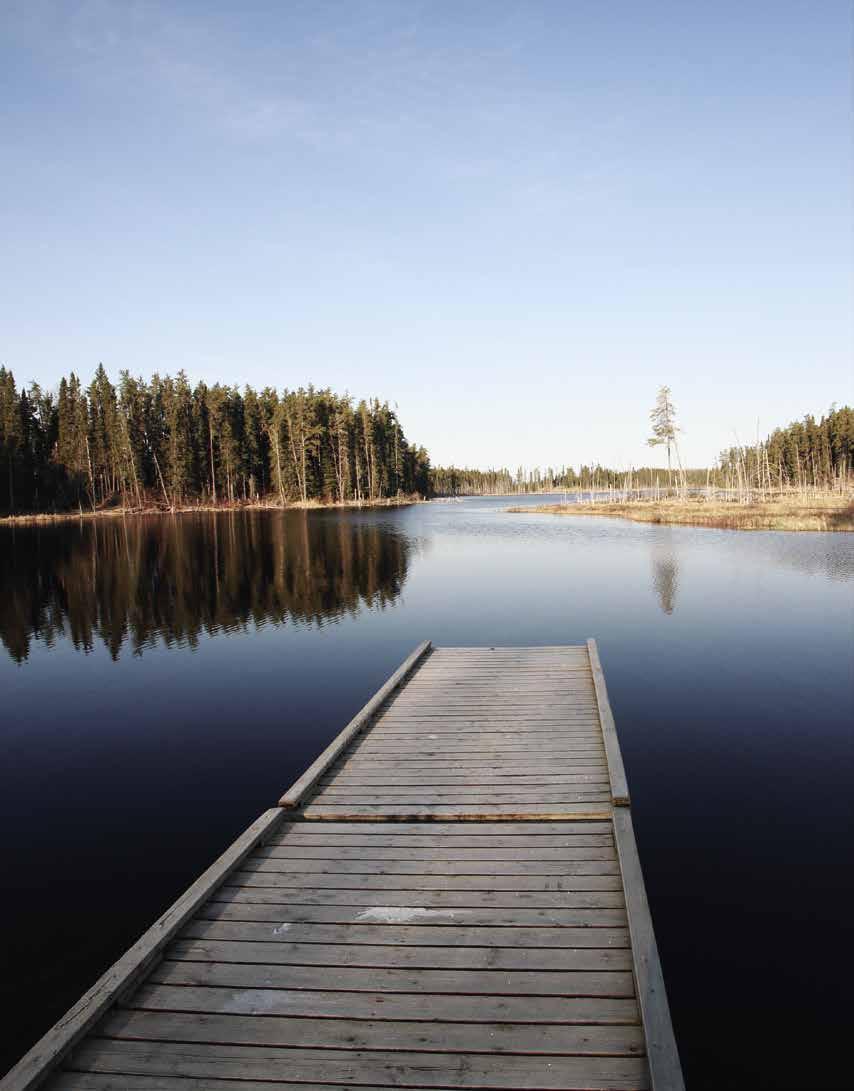 By Dustin Silvey #224778
By Dustin Silvey #224778
Leaving the flat forests of Saskatchewan behind us, we crossed into the lake lands of northern Manitoba. The change in landscape along the road was rapid. One second, we were in the forests and the next we were suddenly riding across causeways that passed over several lakes reminding me more of Scandinavia than my home country of Canada. By the time we crossed the border, the sun was at its peak in the sky, the temperature had started to increase, and the warmth was a blessing that added to the positivity we were both feeling as Janel had completed her first real dirt road ride early that day in Saskatchewan. Things were looking up: the weather was looking good, Janel was riding well, and we were still on the adventure of a lifetime.
After an hour and a half, we made it to the Evergreen Lodge at Clearwater Lake, our destination for the evening. As it was early June, the lodge was empty and we had the place to ourselves. In the afternoon sunshine, we unloaded the bikes, pulled up some deck chairs, and enjoyed the peace and quiet. It was at this point Janel looked at me and asked, “What do we have for dinner?” I examined our food cache and found we had a couple of granola bars and some nuts. “That isn’t going to cut

it,” I thought to myself. Looking at my phone, I determined the closest food was a little burger shack about 10 minutes down the road around the lake. I jumped back on the bike and headed out, not realizing I was about to enter the land of dragons.
Once I got back on the main road, I noticed the sky got very dark. I was a little surprised, as moments ago there wasn’t even a cloud in the sky. Suddenly something smacked into my helmet. Then I felt a few pinches in my arms and finally something hit me in the neck. Coughing, I slowed the bike to around 40 km/hr (25 mph) and realized the darkness that had engulfed me was insects. I took a look at my windshield and noticed several dragonflies clinging to life. I was riding though a swarm of dragonflies! A very uncommon site I am sure, but there is an explanation for it. Canada had a ridiculous amount of rain in 2022, and this led to a larger than normal mosquito population. Mosquitos are food for dragonflies; therefore, the increase in mosquito population led to an increase in the number of dragonflies. Even with me going slowly, once I arrived at the burger shack, I still had to pull out a few dead dragonflies out of my headlight and my helmet vents. Manitoba is well known for having a high population of insects, but this was a bit outrageous.
Checking the bikes upon our arrival.“Bugs are not going to inherit the earth. They own it now. So we might as well make peace with the landlord.”
–Thomas Eisner
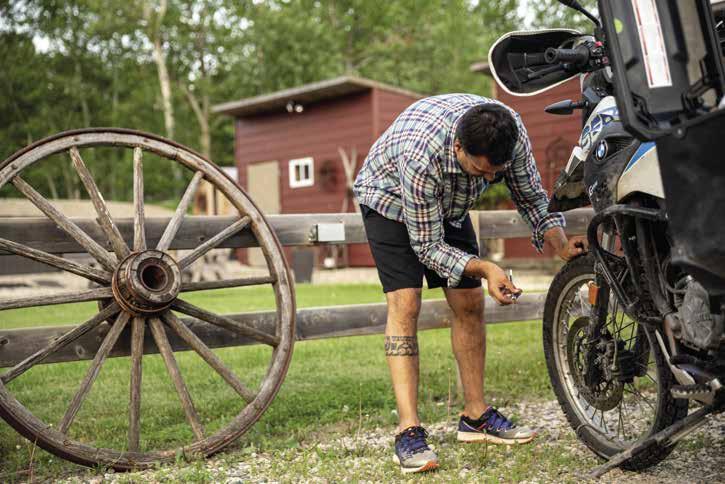

The next morning with the dragonflies asleep, we rode into The Pas, a small town at about the midpoint of north/south in Manitoba. We pulled into the Miss The Pas Restaurant to grab a quick bite to eat before our long day south. As we walked into the busy establishment, the first thing that caught my eye was the lack of remaining wall space: every inch of the walls was covered in photographs and memorabilia from all over Canada. There were old photographs of Canada, Manitoba and Indigenous peoples; it was a like a walk through history as we were taken to our table by the window. While enjoying our breakfast, we checked the weather for the day, hoping for sun, but as they say, “Be careful what you wish for.” The temperature was going to reach 35 degrees Celsius (95 degrees Fahrenheit). I was excited for the sun, but this might be too much.
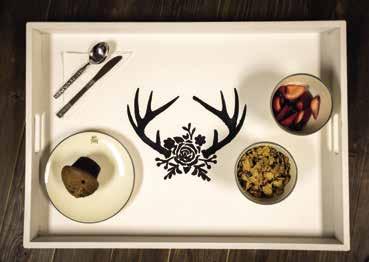
Our destination for the day was just outside of Riding Mountain National Park. Famous for a variety of wildlife, we hoped we would get to see, at the very least, a beaver as we rode through the park. Most of our ride south to Riding Mountain National Park was uneventful. We pulled into a local gas station where the owner denied having a washroom until after we bought some ice cream. I asked him about his stringent rule and he remarked, “We get so many people; we have to police it.” I still laugh to myself about this as he was literally located in the middle of nowhere. How many people could he honestly have visit him? Leaving the bathroom behind and our ice cream eaten, we rode further south. The heat had reached its peak for the day, and I was soaked under my riding gear. All we had wanted for weeks was a nice riding day, and now all we wanted was some cloud cover to cool things off. It is difficult to please some people.
After about six hours, we made it to the park. Our bed and breakfast called Riding Mountain House was located on the opposite side of the park. This gave us the opportunity to enjoy the scenery in the late afternoon sun as it started to cool a bit. This decrease in temperature also brought out the wildlife as they started waking up and searching for food. Not long into the ride I spotted a black bear trotting along the treeline. He/ she didn’t seem to have a care in the world as the bear took its time checking for snacks along the way. Both Janel and I were excited we got to see a black bear. Then we saw another and another, but it wasn’t until near the end of the drive that we saw a mother black bear and her three cubs playing near the treeline. We slowed right down (we did not stop as we didn’t want to disturb them) to watch the cubs jump on their mother’s back while she tried to find some peace from the little brats. The cubs brought smiles to our faces for the remainder of the ride.
Once we arrived at Riding Mountain House, I needed to do a bit of general maintenance on the bikes. I checked the tire pressure, lubed and cleaned the chains and gave the bikes a general check over. Everything looked great, well, on the bikes. The sky had turned an ominous black, and then, just as I was finishing up, it cracked open and started pouring down rain. The hot day had now turned into a thunder shower. I ran back inside where Janel and I watched the storm from the enclosed balcony. It went on for hours with lightening flashing bright, and we finally gave up and headed to bed.
The storm lasted into the follow morning, and we gave up on our hiking plans. Instead, we grabbed our rain jackets and walked into the small town of Wasagaming inside the national park. If you have ever been to Banff or Jasper, Alberta, you get the idea of what Wasagaming is like: a small town with an epic backdrop of a national park. Tourist families wandered the town in their Patagonia, Arcteryx and other weekend warrior gear. Janel and I stumbled onto a bakery, and we each purchased a cinnamon bun to enjoy for an early lunch. With our buns in hand, we walked down to Clear Lake to enjoy the buns (yes, it is a different lake from Clearwater Lake). The storm clouds raged aggressively in the sky over the lake and we sat back and enjoyed the show. Not really wanting to get soaked hiking, we just spent the day aimlessly wandering the town in between the downpours.
The following day the rain was still coming down hard. We were back to riding the bikes in the wet weather as we headed off to Winnipeg. Other than the rain, which wasn’t exactly pleasant, we had a rather uneventful ride. With the bikes unpacked we headed off to the spa. Wait, what!? Let me explain: with this journey across Canada, there had to be some give and take between Janel and I. She was willing to take some dirt highways I wanted to ride, but I had to let her enjoy some fancy relaxation, such as Thermëa by Nordik SpaNature. We spent a day at Thermëa located in Winnipeg, enjoying the baths, saunas, and raspberry lemonades. Janel screamed when she went into the cold waterfall, which I laughed at for longer than I probably should have. The wind and rain had really zapped our energy, and the spa was the perfect place for us to recoup and relax.
The evening before our next ride headed back north, we checked the weather and another scorcher of a day was expected. We geared up early in the morning to race out of Winnipeg before the temperature increased too much and we were stuck in traffic. Our destination for the day was Gimli, an Icelandic settlement about 90 kms (55 miles north of Winnipeg). In 1875, the government of Canada granted Icelandic settlers land along Lake Winnipeg. Gimli has a strong Icelandic heritage and had almost become a sovereign nation at one point. Now, it has
the best cookies you have ever tasted. As was our normal routine, after dropping our gear of at our accommodations, we went searching for food. Walking into Sugar Me Cookie Boutique allowed me the sensation of knowing what Charlie felt like when he walked into the chocolate factory. Emotions of awe, wonder, amazement and excitement all hit me as I tried to decide which sandwich cookie I would pick. It was at this point I realized, “Hey, I am an adult, I can have as many cookies as I like!” Up to this point on the trip I had lost about 10 lbs.; that all was about to come to a change. A lemon poppyseed cookie? I will take three. Oh, a traditional vinarterta cookie?
Yeah, I have to give tradition a try. While we enjoyed an Icelandic statue, beautiful Lake Winnipeg beach, and friendly conversations with the owner at Lakeview Mechanic, I am confident we devoured $40 worth of cookies in Gimli. Seriously, I got fat.
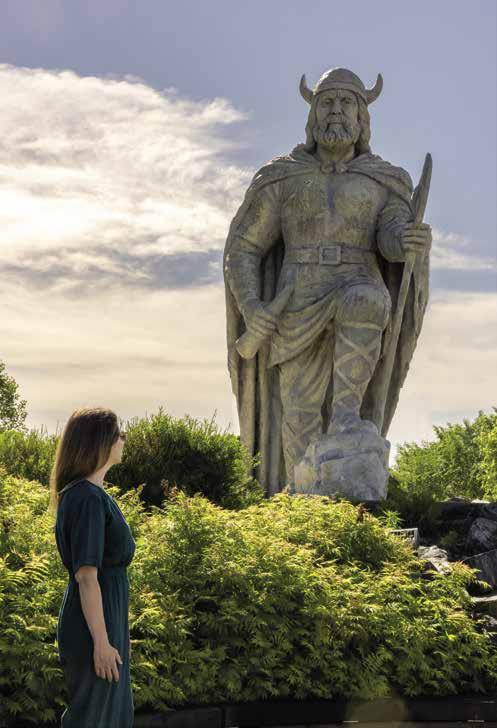
The following day, the sugar hangover was in full effect. I dragged my cookie stuffed body onto the bike with the support of Janel as we prepared for our final destination in Manitoba, West Hawk Lake. Riding through central Manitoba, there wasn’t a lot to look at once we got away from the massive Lake Winnipeg (I wouldn’t fault anyone for mistaking it as an ocean). As we headed more easterly, we started to ride on the Canadian Shield. Large rock faces hugged the roads, the forests became more wild and rugged, and traffic continued to disperse on the more remote roads. We pulled into a nice grassy rest stop that was surrounded by the low rock outcroppings of the shield to grab a drink of water. While we enjoyed the view of the hills, two BMW motorcycles pulled up next to us. We got chatting and it turned out one them was a fellow BMW MOA member. We exchanged stories about the 2022 Rally, our different bikes and our cross-Canada trip. It was like running into a family member you had never met before. That is the great part of being part of the MOA, we never know when we will meet another member and trade some stories, even on a backroad in southeastern Manitoba.
We arrived at West Lake and while I unpacked the bikes, Janel found a cat to entertain herself with. While we were playing with cats and emptying the panniers, the bugs came out. I realized as I sprinted in to our cottage at Tall Pines Lodge, this was not the year to explore the forests of Manitoba. People often joke about the bugs in Manitoba, but really, they aren’t that bad—normally. This year with all the rain, they were just completely out of hand. It rained on us in sheets as we rode the bikes, and when it wasn’t raining, the bugs were savage. Sometimes, you just can’t win.
In our next installment, we head across northern Ontario and into Quebec to ride Route 389 to Labrador.
Clearwater Lake
Clearwater Lake gets its name from the fact the water is so clear you can see the bottom at 11 metres, and it is a beautiful spot known for fishing and boating. If you go, it is worth staying at the Evergreen Lodge. The cabins are great, and the owner is extremely accommodating. They are located right on the lake with spectacular views. Evergreenlodgeandresort.com
Rates start at $120/night ($90 USD) for a cabin.
Riding Mountain National Park
Riding Mountain is home to a diverse number of animals and plants. Most importantly, black bears thrive in the area. We chose our accommodation here based on how close Riding Mountain House was to the park, a ten-minute walk. The owner was very kind and let us do some laundry, had a great breakfast waiting for us, and also let us take advantage of the hot tub. Just a fantastic couple of stormy days. Ridingmountainhouse.ca
Rates are $149/night (110 USD).
Winnipeg
Winnipeg is a large city for Canada with over 750,000 people. There is so much to see and do so you have to pick what you are interested in. Below are a couple suggestions.
The Manitoba Museum (manitobamuseum.ca) has a great history of Manitoba exhibit, along with an Inuit art exhibit. The work is beautiful, and we had the place to ourselves. Admission: $15 ($11 USD)
Thermëa by Nordik Spa-Nature (www.thermea.ca) is the place to visit if you want some rest and relaxation. Grab a drink and just take a break from all that hard riding. Make sure you speak to the operators who will explain the traditional way of moving from pool to pool to really embrace the different culture.
Admission: $79/day ($60 USD)
Inn at the Forks (www.innforks.com) was for us, the best option to stay at. The lovely, quiet hotel is right near a lot of the tourist action, and it has patrolled, covered parking for the bikes. There are lots of restaurants nearby, and the hotel restaurant made some great food. Rates: $300/night ($220 USD)
Gimli
Obviously, you need to visit Sugar Me Cookie Boutique. While you enjoy your cookie, wander along Lake Winnipeg and visit the Viking statue. Gimli is a tourist town, so there are lots of places to eat and enjoy your time. We stayed in the most central place we could, Inn on Centre (www.innoncentre.ca) and were not disappointed. With parking for the bikes and a shaded wrap around deck, we enjoyed our time lazing around the bed and breakfast. Rates start at $130/night ($95 USD)
West Hawk Lake is beautiful, and the drive along the Canadian Shield is fantastic; however, to me West Hawk Lake is Tall Pines Resort (tallpinelodges.com/). The owners have really turned this into a paradise of relaxation for adults. It’s the perfect spot to curl up and read a book, enjoy the jacuzzi, or just walk around the property enjoying the sounds of the wildlife in the area (on years where the bugs are not out in full force). Rates Start at $170/night ($125 USD).
Dustin grew up in Quesnel, British Columbia, and began riding on the back of his father's motorcycle many years ago. He has a doctorate of Community Health with a speciality in Indigenous health. He currently works several contract positions with Indigenous organizations across Canada. Dustin's publication credits include The Globe and Mail, CBC, and Vice News, along with several extreme sport magazines such as Explore, Sidetracked, Canoe and Kayak, and Paddle Magazine. Dustin and Janel currently live in Powell River, British Columbia.

Flying back from Level Three classes at Marine Corps Air Station Yuma, this acceleration subject is on my mind because it was a huge deal over the last few days. It is applicable to riders of all levels and personalities.
Our fighting forces are generally Type A personalities who value training, fitness, success and challenge–not too different from every roadracing champion I have met. We learned long ago that platitudes and preaching do nothing to improve the safety of this type of personality. They buy or build fast bikes with a plan to enjoy the addicting acceleration that our sport offers. Just like MotoAmerica Superbike champion Tony Elias.
A Marine Corps general, now retired, related the Champ school approach to what the Marine Corps learned in aviation training. Years ago, the Marine Corps realized the only way to produce safe pilots was to produce technically excellent pilots. Safety followed skill and no number of words could replace proper techniques, approaches and decisions based on how the airplane was designed to be flown. Make great pilots to make safe pilots. This forms our
curriculum and approach at Champ school in every program we do. Riding safety comes by increasing rider skills.
Aggressive riders repeat this mantra very early in our classes: I accelerate because I plan to brake.
We go beyond the words and get this plan to brake firmly established by practicing straight-line braking and even more importantly, trail braking. The definition of trail braking is trailing brake pressure into the corner or trailing off the brakes as you add lean angle. I include the definition because several Marines in this class were told trail braking was using the rear brake. Yes, we trail brake with the rear brake, too, but trail braking is trading off brake pressure as you add lean angle; it’s mandatory if you want to ride well. “Ride well” means you put your bike exactly where you want it at the speeds you choose.
Our straight-line braking practice revolves around spring and tire loading and unloading, the responsibility of the rider or “on-board engineer.” Springs and tires will take astounding loads but neither do well with abrupt loads, so we work on the engineer who is inputting
loads to the springs and tries to drastically improve braking. For how and what to practice, try this link: cycleworld. com/2016/03/22/ienatsch-tuesdaymaster-your-motorcycle-brakes-13-steppractice-guide-for-braking/.
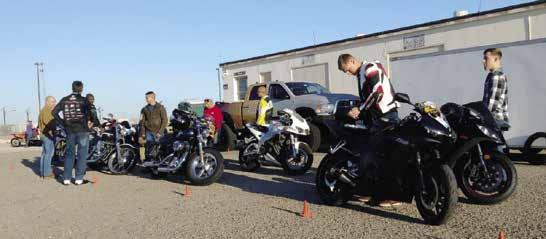
Expert riders never close the throttle without their fingers on the brake lever. Never. They put their fingers on the lever and squeeze the brakes to shed speed for the upcoming corner, intersection or hazard. If they accelerated harder this weekend than last weekend, they would brake more because the corner will not miraculously open its radius for them, they must adjust their speed for the corner. We must adjust our speed for the corner. We must adjust our speed for the corner. Got it?
One huge misconception in our industry is that we ride faster with less brake which is 100% wrong–provably and painfully wrong. Our bikes are designed to steer into the corner with a little bit of brakes on, yet many riders who try to ride fast simply roll the throttle shut for the corner. That is literally “out of control” and we address this during the first moments of every Champ school program.
We all know brakes shed speed, but (almost) as importantly, brakes control our steering geometry and front-tire contact patch. How and when we use our brakes, especially the front brake, is vital to how the bike handles, especially at corner entry. Rushed corner entries lead to riders leaving their lane, mainly because their speed control,
geometry control and front-tire contact patch control were not in place. Expert riders trail-brake and expert riders design our bikes, so if we are not replicating their techniques at our own pace, the bike doesn’t work as designed. That becomes a bigger deal the quicker you ride.
“More Speed, More Brakes” is another mantra our Marine Corps graduates can repeat to you if asked. All things being equal, we will use more brakes on a Honda CBR1000RR than on a Yamaha R3. Riders might know this instinctively, but this knowledge must be at the tippy top of our consciousness. Riding quicker this weekend? Use more brakes to control that speed. Plan to have your right hand roll off the throttle to the brakes to set your corner-entry speed precisely and repeatedly, rather than only close the throttle and hope it works out. Soon, it won’t.

If speed was to blame for single-bike backroad crashes, all my friends would be dead. My wife would be dead, I’d be dead. We like speed, we buy vehicles to enjoy a little speed. The safety issue is not the speed, but the inability to control that speed. I accelerate because I plan to brake. More speed–more brakes. Important mantras, sure, but also industry-growing, championshipwinning plans.
Sometimes the written word is ambiguous so let me try this: The lack of braking, especially trail-braking, is the root safety issue for riders failing to negotiate corners on both street and track. Our industry needs to see a lot more brake light. Rider safety will only improve when we increase rider skill based on the awareness of how the bike is designed to be ridden by the experts who designed it.
Nick’s passion for exact riding instruction comes from his own experience when, as a young motojournalist, he saw that championship-winning racers approached the sport in a technical way. As Nick started racing, he was helped by timely advice from racers who had “been there, done that,” and founded the Yamaha Champions Riding School in 2008 after 12 years with the Freddie Spencer High Performance Riding School. His wall displays AMA #1 plates and he leads the school from the seat of a bike with two main priorities: Safety and Customer Service.
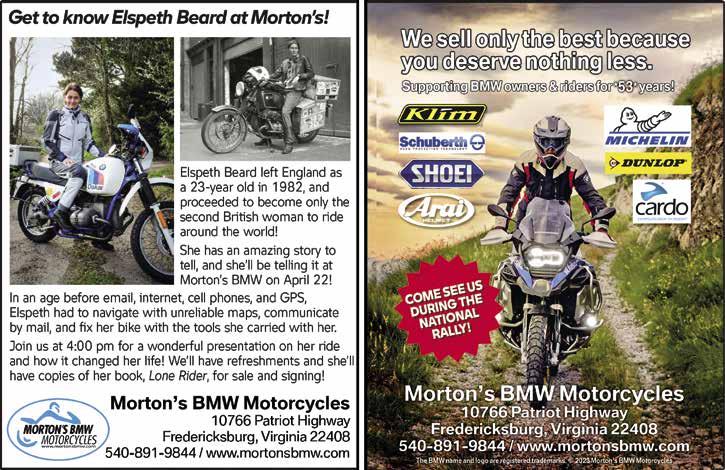
We all have them–those moments in our lives that are indelibly scribed into our brains, when we experience something that will leave a lasting imprint on us. Many times, they may seem inconsequential, but something keeps drawing our memories back to that time. This was one of them for me. It involves motorcycles, the kindness of strangers and good food. And although it was almost 25 years ago, I still recall the details like it was yesterday.
It was in the early 1990s sometime, but in everyone’s recollection, it was one of the dreariest years for Daytona Bike Week. Bulow Campground only offered cold rain and lukewarm coffee, while dampness pervaded the group gatherings. It diminished conversations and camaraderie, subduing even the hardiest of rally rats. Even the V-Twin bikers had given up and gone elsewhere, their rumbling pipes reduced to an occasional backfire in the intermittent rain.
By the day of the “Big Race,” all I wanted to do was to find some place warmer and drier than Daytona. I was tired of waking up to rain dripping on my tent fly, tired of pulling on damp boots to trudge to the bathrooms with the cold concrete floors and dirty porcelain. So, I chose to forgo the races and decided to head south towards the Keys.
With fingers white and wrinkled from the cold rain, I compressed my sleeping bag, rolled up the tent and strapped all of my belongings onto the back of the K 75. There was a fleeting moment when I considered just turning north towards Wisconsin and cancelling the rest of the trip. The lure of my own warm bed whispered in my ear like a lover’s caress, with promises of being embraced in the comfort of home. But commitments had been made, so I reasserted myself to the task at hand and soon was heading south on Highway 1 towards an annual small post-Daytona campout and hopefully, sunny skies and warmer weather
I’ve always found travelling alone to be
a cathartic experience. Hours of silence with nothing but one’s own thoughts offers immense peace. It gives the rider time to evaluate life: personal issues are considered, problems resolved, anger is transformed to acceptance. By the end of the trip, internal strife disappears, and harmony is restored. This was the case as I rode that day, heading ever-south towards the Seven-Mile Bridge and Knights Key.
When leaving the campground at 9:30 a.m., it never occurred to me that the 400-mile ride would be such a hard push. The lack of sleep combined with the first big ride of the year took its toll. The cold drizzle seemed to follow me, covering me with road-spray from the cars as I passed them.
As I rode, I contemplated the hammock in my saddle bag, envisioning two palm trees about eight feet apart. My mind wandered to images of the sunsets from the beach. My mental ramblings had me relaxing with that paperback, which was tucked-in next to the hammock. Eventually, I made it to Homestead, where the evidence of the destruction from Hurricane Andrew still littered the sides of the roadways. My thoughts turned to deep appreciation for my own blessings and empathy for those who were struggling to recover from that enormous natural disaster.
Knights Key finally appeared at dusk. I was physically depleted from riding all day; I had only stopped for gas and the type of sandwiches only gas stations can offer. My leathers weighed heavy on me after ten hours of riding in the rain. Shivering and cold, I parked the motorcycle at my campsite. After stopping to put my hand on the gas tank to whisper a few words of thanks to the bike, I walked to the small pub on the grounds. All I wanted was a dry place to warm up, something to eat and a cold beverage. What I received was a memory.
The Tiki-bar/restaurant was dark, with only a dim light above the service counter and another light in the kitchen.
There was someone quietly singing in the back as they rattled dishes and cleaned up. I stood inside the doorway, holding my dripping helmet in one hand and sopping wet leather gloves in the other, unsure of what to do. The last thing I wanted to do was to get back on the bike to ride anywhere else that night.
The cook peeked out, looking like he wanted to tell me he was closing for the night. Words escaped me. Neither of us spoke for several moments. He had a weathered face and a warm smile which brighten the room a little. With a shrug, he told me he had been putting everything away, but there was a little of his Seafood Bisque left over that he could reheat for me. He also offered some crusty sour dough bread that was about to be tossed out because it was dry after sitting out.
The Seafood Bisque was exquisite with flavors that exploded on my taste buds. It overflowed with shellfish and whitefish from the day’s catch in a creamy tomato soup which was enhanced with white wine. Every mouthful was a delight. I savored every spoonful as the feeling returned to my fingers and toes. I struggle with describing how I felt at that moment. After a difficult winter, a miserable week in Daytona and an exhausting wet ride through Florida, I found peace, thanks to this kind stranger who fed me, let me warm up and dry out and entertained me with random, inconsequential conversations.
Before I wandered back outside to set up my tent, I found the only dry piece of paper I had on me. the back of my check-book register, where I wrote down the recipe. It’s still as good today as it was all those years ago on that wet Sunday evening in March. And every time I make it, I am transported to a different time when life was simpler, when gas was cheaper, when laughter came easier and before the time of electric jacket liners and heated gloves and Gore Tex jackets and GPS units. A time when a stranger took time out of his day to extend an act of kindness to a weary traveler.
Here is the recipe from that night. You can call it Pirate Grog. You can call it Shrimp
Bisque. It’s really not the name–it’s the memories.
• Any seafood (Shrimp, Crab meat, Scallops)
I use about 1.5 pounds (other seafood may also be used...)
• 3 stalks celery, diced
• 1 Onion, diced
• Garlic
• Butter
• 1 C. Chardonnay or other white Wine
• 4 cans Campbell’s Tomato Bisque Soup
• 3 pints half & half
• Salt, pepper, nutmeg, celery salt, to taste
• Pinch of cayenne pepper (to taste)
Dice seafood into ½” size pieces and sauté in butter. Set aside.
Dice celery and onion into ¼” size pieces; add minced garlic. Sauté in butter.
Combine with seafood. Gradually stir in canned soup and half & half.
Add seasonings, to taste. Bring to a slow simmer and reduce heat.
Stir in the Chardonnay.
Garnish with fresh parsley.
Serve with kindness, day-old crusty bread, the rest of the Chardonnay and some quiet Caribbean music.
I’ve enjoyed Ron Davis’s columns and stories for a long time…he does what all the best motorcycle writing does: he makes you wonder why you aren’t out there riding your own bike, right now, except during the long Wisconsin winter, when his work simply helps you stay sane until spring.”

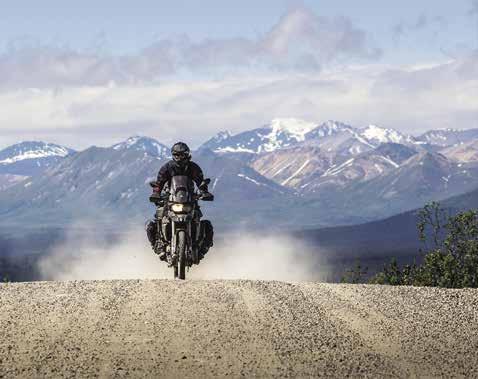 —Peter
—Peter
Egan, Author of Leanings 1, 2 & 3
ISBN 978-1-890623-74-6,


252 pages, $19.99 SRP
Sue was an avid bicyclist prior to being introduced to motorcycles in 1987. That was when a friend invited her to a BMW rally in Escanaba and her interests ratcheted up to motorcycles. Since that time, she has accumulated 500,000 miles on her bikes, and has chaired four MOA National rallies. (Midland, MI; Lima, OH; West Bend, WI; & Billings, MT)
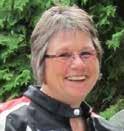
In 1997 she was made an ambassador and has also served as the Ambassador Liaison.
Additionally, Sue served multiple terms on the MOA Board of Directors and was honored to receive the prestigious Friend of the Marque in 2018.
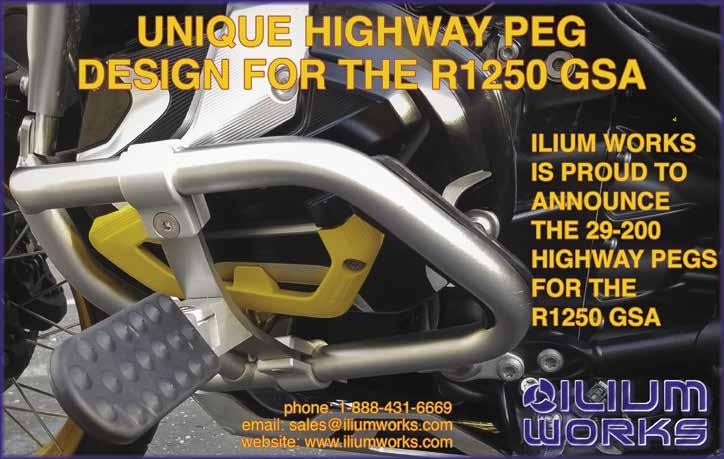

In our continuing efforts to bring innovative products and services to our membership, the MOA is excited to offer The Lifestyle Collection. For the first time, the MOA and Klim are offering co-branded apparel. Klim is the global leader in designing, developing and manufacturing, the most advanced technical riding gear and motor sports apparel for motorcycle riders.

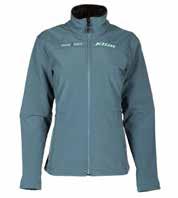


I just returned from a ride with an odd goal: find rain. I was trying to test the weatherproofing of Aerostich’s Transit 3 leather suit, which incorporates a unique combination of non-absorbent leather and a one-way water-permeable membrane to keep rain out while allowing water vapor to escape from inside. Although I could see multiple showers in the distance and on my Garmin Zumo XT’s handy live weather map, I was never able to catch up with one. Of course, had I been trying to avoid them, each one would have chased me down and taken its turn soaking me!
Although my intended mission remained unaccomplished, I unexpectedly succeeded at another. I learned how the Transit 3 “worked” in the hottest, most humid weather encountered since I acquired it in early spring. Back when temps were cool and the air was dry, its comfort was impressive. This wasn’t surprising, given its high-quality materials, design and craftsmanship, but I’ve been wearing synthetic textile gear almost exclusively for many years, with all my old leather jackets and suits collecting dust—along with my memories of roasting inside them, soaked in sweat during summer rides, even when the leather was perforated. Once they became available, textile replacements with extensive venting or mesh panels were a most welcome relief, and I’ve rarely donned leather since making the switch. Despite Aerostich’s claims about the Transit 3 being an all-weather option and my longstanding regard for the company’s products, I was skeptical about using it through the worst of summer in the southeast, where temperatures and humidity typically hover together in the upper 90s. Things aren’t quite that bad here yet, so it remains to be seen how the Transit will feel in more extreme conditions, but my outing saw dash thermometer readings approaching 90
and, with all those pockets of rain around me, the atmosphere was dreadfully muggy.
The Transit 3’s leather is perforated but allows no ingress of fresh air except through its relatively limited underarm and upper-back zippered vents. Those perforations only allow the waterproof and windproof membrane to pass moist vapor to the suit’s exterior. I would not have guessed this could produce much of an evaporative cooling effect and, indeed, it’s certainly not on par with a well-ventilated or mesh garment. However, I repeatedly noticed I wasn’t as sweaty and hot as I had expected. Aerostich also claims the special dyes used in this suit reflect more radiant heat than those used in conventional leather. I can’t vouch for this in any objectively measurable sense, but again, I noticed less impact than anticipated from the sun beating down on me between cloudy areas. I clearly recall similar conditions generating a lot of misery when wearing leather kit in years past, especially during the initial transition into hot weather when I hadn’t yet acclimated to the seasonal change (as is currently the case). It seems the Transit 3 actually does deliver significantly greater comfort than conventional leather as the mercury and humidity climb. I wouldn’t have believed this possible, and therefore I also wouldn’t have considered purchasing a Transit 3, regardless of the catalog’s description. My view changed only because Aerostich generously provided a sample for evaluation.
This column isn’t meant to be a review of the Transit 3. Rather, I’m trying to illustrate how things we think we know can prove quite inaccurate when tested. Only the most grandiose narcissist explicitly insists they’re never wrong about anything, but we all believe our own opinions and expectations as though we’re implicitly infallible; it’s just
that some of us can occasionally take a more humble and accepting stance when evidence comes in to the contrary. It’s important to deliberately maintain a bit of doubt about our own perspectives, leaving room for new information to continually improve the accuracy and comprehensiveness of our views. For better or for worse, feelings are not facts, nor are ideas. Our thoughts and emotions almost always have some validity on the basis of our individual histories (They don’t just come out of nowhere), but they can become obsolete as our situations and selves change. Much damage and distress is a result of misapplying the past to the present. For example, the way I learned to relate to others in my family of origin may be way out of step with how I need to relate to (at least some of) the folks in my present circle of friends and coworkers. Whether we’re talking about leather riding suits or interpersonal dynamics, things can change a great deal over time and from one setting to another. We ignore the need for updating our understanding at our own peril; others we care about may suffer negative consequences from our rigidity as well.
When I work with couples, one of the most common problems I encounter is a lack of curiosity. Each partner has become convinced they know all there is to know about the other one, and they work off the static models they’ve established in their minds as they interpret and react to each other. (This is also almost always the case between parents and their children.) The truth is no one is ever completely known by another person; we’re all way too complex and elaborate for this to ever be possible, and even if we were to be fully known one day, there would be new things to learn the next day about our experiences, thoughts and feelings since the previous assessment. I don’t mean partners are all wrong about each
other, but those fixed models can contain plenty of inaccuracies, omissions and outdated concepts that lead to seriously problematic misunderstandings. Much of couples therapy involves facilitating renewed exploration and discovery. Whereas this was what made the early stages of the relationship exciting, it eventually became intolerably stressful as one or both individuals reached a point where they didn’t really want to reveal any more about themselves or find out potentially disappointing or disturbing things about their partner. Curiosity got shut down to avoid anxiety, grief or the need to adjust, and as a result the relationship became stale and calcified. The partners no longer queried each other about how they saw or felt about things, and instead assumed and speculated on the basis of those old models—often in spite of new or different information their partner tried to present. This made their relational problems unsolvable.
Something similar happens in the garage. If I’m troubleshooting with a closed mind, thinking such-and-such must be what’s wrong or something else can’t possibly be the cause, I’m likely to miss clues that would lead me to a more accurate and useful appraisal. I’ve spent far too many hours tracking down gremlins that didn’t exist after overlooking extremely simple and obvious fixes (always check the kill switch first, no matter how certain you are you haven’t touched it since the last ride!). Even when I didn’t miss something basic, gaps in my knowledge have caused me to leave out certain paths of inquiry, eventually considered only after ruling out everything else or consulting someone with more sophisticated understanding. Had I realized the existence of such connections at the outset, I might have started with them and saved myself a tremendous amount of time, effort and consternation.







There’s a counterargument to be made here. We can’t go through every activity of every day without making any assumptions or we’d never get anything done. I’m not going to go through some systematic test of my office chair’s weight bearing capacity prior to each time I want to sit in it! The ability to assume is a big part of what makes memory an invaluable necessity in daily living, and we’re right to take a multitude of things for granted. Our experiential histories allow us to make countless accurate predictions about what will likely happen in the future and judge which actions will yield the desired outcomes. The problem isn’t so much our tendency to assume, it’s how we often take our assumptions too seriously, foreclosing on the opportunity to learn when faced with a challenge. Assumptions must be made, but we ought to hold them loosely. We need the flexibility to shift into scientist mode quickly when our assumptions don’t fit the emerging evidence. Forming new hypotheses and testing them in logical, methodical ways is the foundation of all scientific knowledge. Yet even the most rigorous and earnest scientist is vulnerable to a basic principle of human nature: instead of believing what we see (the scientific ideal), we tend to see what we already believe. We have to deliberately push against this tendency if we’re going to pry open space for new information at variance with our preconceived notions, and we need other people who can see things from different vantagepoints to help us notice our own blind spots (by definition, these cannot be discovered solo). This all takes real work and a great deal of humility.
On one hand, the human mind is unfathomably intricate and capable of astonishing feats, not just during moments of genius, but throughout mundane existence. It’s impossible to inventory all the stuff it manages, moment by moment, during a routine day. On the other hand, any particular

mind’s processing can be profoundly constrained and distorted by its own idiosyncratic history of experience. Also, we can err in both directions: we might take our past experiences so seriously we’re unable to appreciate anything new, or we can not take our past experiences seriously enough and continue making the same mistakes going forward. There’s no way to “set it and forget it;” maintaining a reasonably successful life requires ongoing reevaluation of our own perspectives. To make this even more complicated, we can’t even be fully aware of ourselves, given the inevitable presence of blind spots and underlying layers of processing of which we may have little or no conscious awareness. Learning never ends, or at least it shouldn’t. Thanks for the reminder, Aerostich!
Mark Barnes is a clinical psychologist and motojournalist. To read more of his writings, check out his book Why We Ride: A Psychologist Explains the Motorcyclist’s Mind and the Love Affair Between Rider, Bike and Road, currently available in paperback through Amazon and other retailers. Also check out Mark’s podcast version of The Ride Inside, with essays and interviews, available through your favorite podcast app or online at BMWOwnersNews.com.










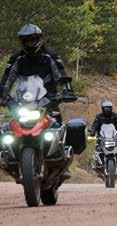


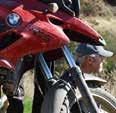


In 1968 when I was 10, Dad got the kids a mini bike. I’m more comfortable on wheels than I am on my feet. I grew up in a motorcycling neighborhood. Everybody had a bike, and the kids rode off-road.
There’s Mount Palomar Road in San Diego, California–a twisting, turning, and diving road up to an observatory on the top of a mountain. It’s a great ride up and down. Now I live in Connecticut, but when I lived in California, I had an old 1976 R 90/6. On those kinds of roads, it was phenomenal. I still have one of my old BMWs–a 2002 R 1200 C Phoenix. It’s bright yellow and black with about 40,000 miles on it. It’s a lot of fun.
Every motorcycle I’ve had since 1990 has been a BMW. I knew about BMW motorcycles for years before I even knew they made cars, too. I got hooked on cruisers. When they came out with the R 18 in 2021, I decided I needed one. When I saw that they had the R 1250 low suspension in the corner, I bought that instead and said I’d be back for the R 18. I was back for it six months later.

It’s been an exciting couple of years that have really been the combination of a lifetime of aspirations. I feel like James Bond when I go to my garage. There have been rides where I go out, hurry home partway through it, get a different bike, and go for another ride. The best motorcycle in the world is the one I’m on. It’s important to go through life and find moments of joy here and there with certain people while doing certain things. I do a lot of motorcycle therapy, and my motorcycle therapy is the best thing in the world. It keeps my head on straight. I always have a smile and a nice thing to say to everybody.
At some point, you make a decision and realize it really is your decision on
whether it’s going to be a good day or not. It becomes a habit, and then you don’t even have to think about it–every day is just a good day.
My brother had a motorcycle just like the BMW R 27, and it was the most beautiful thing I’d ever seen in my life when he rolled into the driveway. I took one look at the motorcycle, and that ignited my interest in riding and BMWs. The sounds of a motorcycle just get me. I can hear how precise the engines are, and that’s what got me into motorcycles. He still has that first motorcycle, and he’s got some serious miles on it.
I’ve had so many unforgettable rides, and they’ve all been wonderful. My first trip was back in 1973, and I was on my R 27. I was going into the Badlands in South Dakota, and I’d never seen anything like it in my entire life. I’m a little Connecticut guy, and I felt so insignificant because I

was so small in that huge area. It was powerful. When we were there, there happened to be a full moon, so we were camping out with a full moon at the Badlands. It was unbelievable.
I love going out and riding because I love the feeling and looking around. Being in the moment is so beautiful and being on a motorcycle centers me. I just feel present, and I feel an enormous amount of gratitude to this day.
I went to a BMW MOA event a while ago, and I took a group of customers. This was when I owned a motorcycle shop, and I led eight or nine customers to that rally which was really fun. I also went to a rally here in Connecticut, and I was the servicing dealer for that rally. It was memorable because of the extraordinary cross-section of people I met servicing their motorcycles.
I love the BMW MOA, and I love getting the magazine. I read it from cover to cover.
I always had a passion for motorcycles, it was in my DNA. I enjoyed the freedom of riding.
I was a member of a hiking club and packed up some camping gear on the back of my R 100 GS and took off. That ride, round trip, was 600 miles. It was a weekend trip, and I hiked and camped.
I’ve been to a rally in Pennsylvania. I was always partial to the GS, the ruggedness, and the fact that it can go anywhere. I bought a street R 65 because I got a little bit older and was concerned about the heaviness of the GS. That was a favorite. They all seemed to be reliable.
The benefits of the MOA are being a part of a community and a sense of camaraderie. I consider myself a biker. I’ve ridden with friends, and we had some fun days on the bike. Once you broke away from all of the mayhem and congestion, it was freedom out on the open road.
In 1976, I was a private pilot, and I get that same enthusiasm while riding motorcycles.
I met my husband, who passed away two years ago, on a motorcycle. He’s the one who got me into BMW.
I’ve had so many phenomenal rides. I was a motorcycle tour guide, so I’ve ridden all over the United States, lower Canada, and in Europe. I don’t think about anything else while I’m doing it. I enjoy the moment and the nature all around me.
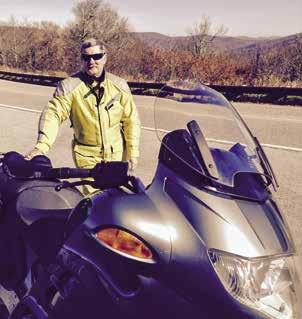
I’ve owned BMWs since 1981 and nothing else. I love the way they ride. I really enjoy having the telelever front suspension, and now I’m trying to get used to all of the technology–it’s smarter than I am.
Being a woman rider, it was hard to be taken seriously as a rider. I saw owning a BMW as a way of showing people that I was serious about the sport. I became a motorcycle safety instructor and after that, I started leading tours, and I had my own touring firm for a while. That changed my life because even my profession revolved around BMW.
I’ve also worked for BMW for a while as a product specialist and a demo lead rider. I like nationals and enjoy the people and have made a lot of friends. I am getting back into it and trying to recreate the MOA family that I had earlier. It’s a good sense of belonging to something.
I enjoy the fact that you can have ten people from all walks of life sitting around in a group and talking to each other civilly. Everybody has a common bond, and we treat each other as equals.
What sparked my interest in riding was when I was about 14 years old and a friend of mine had a scooter. He was often riding it around the parking lot at a country club where I used to swim.
I bought a BMW in 1978 from a dealer in Clinton, Pennsylvania. When I took it in for my first oil change, the owner said there was a little BMW 650 outside and told me to take it to the gas station down the street and fill it with gas. I don’t believe I brought that bike back. I called him and asked how much I owed him. It was one of those things, and we became best friends. That BMW turned into an LS 650, and the LS turned into a 100 RS. After that, I was buying a new RT every year. What I enjoy most about riding is being out there in the air.
I started riding around the age of 11, which started my journey down the road to riding a BMW. My interest in motorcycles started when I was riding bicycles as a youngster. Bicycles led to minibikes, and minibikes led to dirt bikes.
My first BMW was my 1976 R 60, and I still have my 2004 R 1150 RT. I’ve been riding on the street since 1976 and am still a Motorcycle Safety Foundation instructor and have worked at some of the BMW rallies as an instructor. I appreciate the way BMW and the BMW MOA support motorcycle safety. I have also taken full advantage of the Paul B. Grant, and about a year ago, I utilized that to take a trials bike class, which was wonderful.
One of the most awesome things about the BMW MOA is that it supports motorcycle safety, and I appreciate that. I’ve done a few long rides on my BMW. I finally got my 1000-mile Iron Butt SaddleSore by riding from Colorado to Kentucky. I liked the National Rallies and the recent rally in Great Falls, Montana, has been my favorite. I traveled 5,215 miles during that two-week period. My friend, Ron, rode with his service dog in his sidecar rig, I rode my bike, and we had a great time.
Alyn Adrain Providence, RI
David Aherron Montpelier, VA
James Albuquerque Triangle, VA
Denise Allen Tacoma, WA
Mark Allen Novato, CA
Claude Alphonso Ottawa, ON
Edward Anderson Palos Park, IL
Bevin Andres Christopher Lake, SK
Kathryn Andrews Fancy Gap, VA
Paolo Appley Cleveland, OH
Warren Archer Willits, CA
Tim Arms Kingston, TN
Ryan Austin Victoria, BC
Sean Baber Penrose, CO
Zee Baig Aurora, IL
Gordon Balbar Sherwood Park, AB
Ryan Barnes Yuma, AZ
Steve Barnhart Santo, TX
Jonatan Barro Salas Altamonte Springs, FL
Mike Bartells Mechanicsville, VA
Mark Bartels New Richmond, WI
Jonathan Bartleson Rome, GA
Jeremy Basse Boise, ID
Bruce Baynham Newmarket, ON
Chris Beauchemin Victoria, BC
Preston Bebee Kerrville, TX
Aldo Bermudez Mexico City
Nicolas Bernal Naples, FL
Steve Blackwood Half Moon Bay, CA
Chuck Blair Lake Stevens, WA
Andy Boesel Maumee, OH
James Bowling Woodford, VA
Steve Braley Cudahy, WI
Joseph Brandt Little Falls, NY
Randy Bresnik Houston, TX
Michael Britton Newport News, VA
Matthew Brown San Antonio, TX
Bradley Brownell Cleveland, OH
Phil Bucay Newark, DE
Tracy Buchanan Sacramento, CA
Jerry Buck Denver, CO
Roger Burton Glenview, IL
Pat Cacace Navarre, FL
Scott Cain Springfield, MO
Steve Carlson Chesapeake, VA
Tyson Carver Canyon Lake, TX
David Clark Richardson, TX
Steve Coates
John Coleman Dove Creek, CO
Gary Curtis Stafford, VA
Jim Cushman Fort Worth, TX
Barry Davidson Charlottesville, VA
Stephen Davis Bend, OR
Larry Davis North Lima, OH
Gerad Davis Bayside, CA
Homero DeBarros Ft Lauderdale, FL
Shirish Deshpande Nashville, TN
Scott Dessel Santa Maria, CA
Sam Dileonardo Aurora, IL
Adrian Dixon Doncaster East, VIC
William Dombo Hermosa Beach, CA
Kevin Donoghue Carpinteria, CA
Russ Doran Lakewood, CO
Stefan Dordevic Chicago, IL
Adam Dragon Cummington, MA
Don Drumm New Port Richey, FL
Michael Dunaway Annapolis, MD
Vivian Ellis Mechanicsville, VA
Reynold Erickson Calgary, AB
Brent Ernst Wasilla, AK
Thomas Evans Gainesville, GA
Robert Exelbert Staatsburg, NY
Joseph Fazekas Plainfield, IL
Jay Finlon Wapwallopen, PA
Eric Fontaine Shapleigh, ME
Benjamin Ford Marana, AZ
Janie Fox Marysville, WA
Charles Fox Nacogdoches, TX
Wayne Franklin Pensacola, FL
John Fulton Fontana, CA
Daniel Garcia Wanatah, IN
Robert Gardere Richardson, TX
Roland Garner St Johns, FL
Sara Garofalo Parrish, FL
Jeffrey Gettis Schaumburg, IL
Quan Giap Charlotte, NC
Clinton Gilder Elgin, OK
Mike Gilroy Anchorage, AK
Stephen Gormley Waterdown, ON
Thomas Graack Omaha, NE
Mike Grantham Buffalo, NY
Michael Grossheim Joliet, MT
Nathan Hall Indian Trail, NC
Stacey Hanson Marysville, CA
Gary Hartley Cape Coral, FL
Michael Harwood Boerne, TX
Gary Hayek Danbury, WI
JD Hayes Bedford, IN
Kendrick Heath Louisville, KY
Jacob Heibeck Rawlins, WY
Sean Herring Tigard, OR
Jason Hertzberg Coral Gables, FL
Daniel Herz Easley, SC
Jake Hickman Las Vegas, NV
Erle Higgins Ottawa, ON
Bob Hinton Fowlerville, MI
Dave Hixson Baldwin City, KS
Scheid Hodges Spotsylvania, VA
Mark Horner Montross, VA
Steve Hourigan Shingle Springs, CA
J T House Springfield, MO
Travis Howard Jacksonville, NC
Bob Hubble Lansing, MI
Donald Hulin Von Ormy, TX
Elisa Ivanich Apple Valley, CA
Andy Jansky Vero Beach, FL
David Jenkins Dallas, TX
Stephen Jensen Killeen, TX
John Jones Decatur, GA
Michael Jonrowe Willow, AK
Ernie Joseph Seattle, WA
Parag Joshi New Hyde Park, NY
Stefan Kaemmer Santa Barbara, CA
Cody Kamrath Pardeeville, WI
Thomas Kann Wisconsin Rapids, WI
Yoni Kaplansky Champaign, IL
John Keating Olney, MD
Jason Kindrick Yukon, OK
Michael Kipe Rockwall, TX
Dan Kirk Carrollton, OH
Scott Kirkpatrick Greenville, TX
Richard Koenig Gardiner, NY
David Lageson Bozeman, MT
Steven Lamarco Victor, NY
Tom Landis Big Pine Key, FL
Steven Landry New Glarus, WI
Frank Lane Melbourne, FL
Cesar Lanuza Northbrook, IL
Robert Larsen Lynnwood, WA
Howard Laycock Hermosa Beach, CA
Nathan LeCompte Mill Spring, NC
Kelly LeCompte Mill Spring, NC
Seth Lehner Annapolis, MD
Richard Lim Burr Ridge, IL
"I have been planning to attend the 2023 MOA Rally in Virginia, and as a Airhead rider I took advantage of the digital membership option that I heard about on the Airhead247 Podcast. I love to explore the smallest roads on the map in Canada and the U.S.. Anywhere, it does not matter as long as there are twisty secondary roads and the occasional gravel option. I am happy on my bike with a bit of food and my tent."
 –Gary Davidson #232108
–Gary Davidson #232108
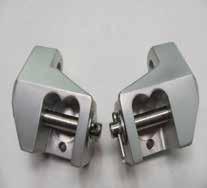

Scott Limke Oklahoma City, OK
Yvette Loiselle Whitewater, WI
Randy Long Golden, CO
Jeffrey Lunger Richmond, VA
Terry Magee Powell, OH
Shayne Manning Cincinnati, OH
Adam Marcum Bristow, VA
Michael Margulis Port Washington, NY
Frank Martin Panama City, FL
David Matysik Sullivan, WI
Spencer Mayott Woodbridge, VA
Jack McBride Oklahoma City, OK
Maxwell McCullough Louisville, OH
Ken McGrath Huntersville, NC
Rowan McQuarrie Missoula, MT
Thomas Meola Omaha, NE
Victor Michelena Potomac, MD
Ronald Milligan Oklahoma City, OK
James Moffitt Port Ludlow, WA
Terry Moran Sausalito, CA
Billy Morgan Baskerville, VA
Carl Morris Rusk, TX
Mark Mullery Palm Harbor, FL
Oliver Mulligan Charlotte, NC
David Natter New York, NY
Nathan Nolte Penrose, CO
Jenna Novic Atlanta, GA
Eric Odinski Oakmont, PA
Kenneth Odom Bankston, AL
Pete Ortiz Mechanicsville, VA
Adam Ozcan Wayne, NJ
Ricky Parks Saint Cloud, FL
José Perez Cumming, GA
Matthew Peterson Taos, NM
Shannon Plesser Fayetteville, NC

Jim Popp Chandler, AZ
Dale Potter Columbia, MO
Darrell Powell Union Hall, VA
Paul Powell Sacramento, CA
Michael Powell Dahlonega, GA
Jeffrey Prupis Tucson, AZ
James Reynolds Lawrence, KS
Alec Reynolds San Antonio, TX
John Rife Greensboro, NC
Nick Rinehart Pasco, WA
Mel Roach Midlothian, VA
Hiram Rodriguez Agawam, MA
Jayden Roebuck Taylor, MI
Thomas Roemischer Brooklyn, NY
Shag Russell Bradford, PA
Kelsey Sacchi Sammamish, WA
Henry Saint-Fleur Orleans, ON
Frank Sauer Hardwick, VT
Linas Savickas Orland Park, IL

Sandy Schackman Plano, TX
Ronald Schiller Fort Rucker, AL
Dieter Schmitt Fortuna, CA
Matthew Scott Austin, TX
Calvin Scott Denver, CO
Adam Sech Kouts, IN
Christopher Seefeld Conway, AR
Victor Settergren Montgomery, IL
Navid Shafieirad Denver, CO
Parry Sharbono El Reno, OK
Arnold Shirk Hampstead, NC
Matt Shoffstall Virginia Beach, VA
David Smith Bellaire, TX
Terry Smith Indian Trail, NC
Brandon Smith Kerrville, TX
James Spencer Radford, VA
James Spencer Warren, OH
Edward Sperber Montclair, NJ
Donovan Stair Gervais, OR
Thorlief Stangebye Minneapolis, MN
Kurt Stanley Derby, KS
Jere Starks Pioneer, CA
James Stewart Clifton, VA
Kurt Stolpa Marietta, OH
David Stone Houston, TX
Averie Stovall Columbia, MD
Elliott Straub Paducah, KY
Brad Tawzer Bend, OR
Kenneth Thacker Hillsboro, VA
Claude Therien Dorval, QC
Kyle Thibaut Venice, CA
Matthew Thomasson Oklahoma City, OK
David Thompson Baton Rouge, LA
Gordon Tibbs Gilroy, CA
Dean Tonkin New York, NY
Rob Toy Los Altos, CA
Ken Uhl Mount Shasta, CA
Sebastiano Uzielli De Mari Bloomingdale, IL
Peter Valenti Georgetown, TX
Katrina Van Marter Englewood, CO
Matt Van Wicklen Flint, TX
Ed Veldkamp Ottawa, ON
Mario Villegas Romero Nokesville, VA
David Volenec Blair, NE
Kristin Von Donop Brunswick, ME
Kathy Walsh Millsboro, DE
Dan Walting Nanticoke, PA
Phil Watkins Huntington, WV
Jarrod Weaver Georgetown, TX
Robert Weiss White Rock, NM
Doug Wheeler Oakton, VA
Patrick White Gurnee, IL
Steve Whitmire Travelers Rest, SC
Benjamin Wise Edmond, OK
Andrew Woodring White Lake, MI
Scott Wright Mapleton, IL
Glenn Wright Alexandria, VA
Alberto Yanez Dallas, TX
Sam Yang Gaithersburg, MD
Mark Yates Mechanicsville, VA
Mario Zannetti Destin, FL
Eric Zimmerman Los Angeles, CA

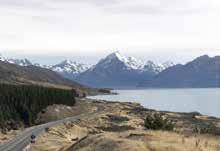





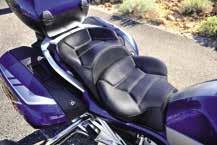

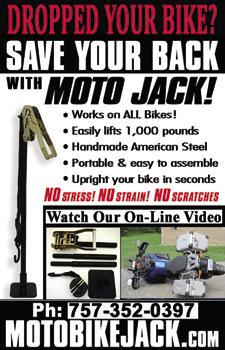

4/21/2023 – 4/23/2023
CAMPOUT AT THE SONGDOG RANCH Mariposa, California tourcaptain@bmwnorcal.org
5/25/2023 – 5/29/2023
BMW CLUB OF NORTHERN CALIFORNIA 49ER RALLY Mariposa, California 49erchair@bmwnorcal.org
6/22/2023 – 6/25/2023
43RD ANNUAL CHIEF JOSEPH RALLY John Day, Oregon bmwro.vp@gmail.com
6/24/2023 – 6/25/2023
CAMPOUT AT UNCLE TOMS CABIN Pollock Pines, California tourcaptain@bmwnorcal.org
7/13/2023 – 7/16/2023
CASCADE COUNTRY RENDEZVOUS Cashmere, Washington rallymaster@wsbmwr.org
7/28/2023 – 7/30/2023
CAMPOUT AT BEAR RIVER Colfax, California tourcaptain@bmwnorcal.org
8/11/2023 – 8/12/2023
30TH BLUE BUTT RALLY Virginia City, Nevada bluebuttrally@gmail.com
8/17/2023 – 8/19/2023
MIKE MCPEAK MEMORIAL RALY Village of Nakusp, British Columbia milkemcpeakrally@hotmail.com
8/26/2023 to 8/27/2023
CAMPOUT AT BADGER FLATS Lakeshore, California tourcaptain@bmwnorcal.org
10/28/2023 – 10/29/2023
OCTOBERFEST
Manchaster, California tourcaptain@bmwnorcal.org
5/5/2023 – 5/7/2023
MOA GETAWAY AT SANTA FE Santa Fe, New Mexico membership@bmwmoa.org
7/20/2023 – 7/23/2023
TOP O’ THE ROCKIES RALLY Paonia, Colorado topotherockies@bmwmcc.org
8/17/2023 – 8/19/2023
25TH ANNUAL BEARTOOTH BEEMERS RENDEZVOUS Red Lodge, Montana registrar@beartoothbeemers.org
9/22/2023 – 9/24/2023
19TH THUNDER MOUNTAIN RENDEZVOUS Hotchkiss, Colorado aesurvey@aol.com
4/14/2023 – 4/16/2023
HILL COUNTRY HANGOUT Kerrville, Texas makowski.michael@gmail.com
4/16/2023
39TH WILD GOOSE RUN Beaver Dam, Wisconsin brianjustman@kewaskumpig.com
4/19/2023 – 4/23/2023
22ND RENDEZVOUS (RDV) Tellico Plains, Tennessee hans.c.koeller@gmail.com
4/28/2023 – 4/30/2023
GREEN COUNTRY OKLAHOMA ADVENTURE TOUR Moodys, Oklahoma jgifford@bmwmoa.org
5/6/2023
2023 MOTORCYCLE FLEA MARKET AND MOTOEXPO
Leaf River, Illinois rockbmw2000@yahoo.com
5/19/2023 – 5/21/2023
GREAT RIVER ROAD RALLY Soldier’s Grove, Wisconsin rally@madisonbmwclub.org
5/19/2023 – 5/21/2023
NATURAL STATE CAMPOUT Morrilton, Arkansas jimmyjoe@windstream.net
6/1/2023 – 6/4/2023
LAND OF OZ RALLY Paola, Kansas moa_84843@yahoo.com
6/2/2023 – 6/4/2023
46TH HIAWATHA RALLY Houston, Minnesota murdaughm@gmail.com
6/23/2023 – 6/25/2023
MOTOMO RALLY 2023 Crane, Missouri kronie12@gmail.com
8/19/2023 – 8/20/2023
MS RIVER ROAD RUN Monticello, Minnesota lee@hamlineconstruction.com
9/8/2023 – 9/10/2023
52ND ANNUAL WISCONSIN DELLS RALLY
Wisconsin Dells, Wisconsin barnrazer@yahoo.com
9/21/2023 – 9/24/2023
2023 PURE STODGE IOWA RALLY Elkader, Iowa pstarally@gmail.com
9/29/2023 – 10/1/2023
CENTRAL OKLAHOMA BMW ROAD RIDERS ANNUAL CAMPOUT Talihina, Oklahoma tburull@hotmail.com
11/3/2023 – 11/5/2023
53RD SOUTH-CENTRAL BMW OWNERS REUNION Fayetteville, Texas vp@bmwclubofhouston.com
JOIN US FOR THE


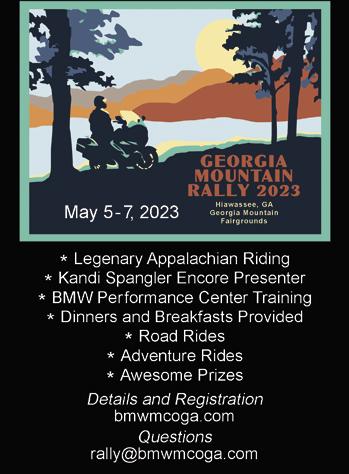
NEW LOCATION:
Agassiz Village
71 Agassiz Camp Road
Poland, Maine 04274
GPS: 44.0385 N, 70.4727 W
www.agassizvillage.org
FOR MORE DETAILS AND REGISTRATION: www.bmwrsm.org/downeastrally or follow us on Facebook
2023
• Free camping, showers, firewood
• Nearby hotels and food
• Guided road and dual-sport rides
• Friday night burgers
• Saturday night legendary steak and chicken
• Local charity breakfast Saturday and Sunday
• Free coffee and drinks
• Door prizes and awards
• Free rally pins and swag to first 250 attendees
Burkesville, KY • May 18 - 21 bmwmcon.com
Flea Market and MotoExpo
37th Annual kwahkcalB eR g i on BMW Assoc
NEW Indoor Venue!
Welcoming: BMW and All Marques from Europe and Japan!
River Valley Complex in Leaf River, IL 605 Main St, Leaf River, IL 61048
GPS Coordinates: 42.12145, -89.40345
Admission - $5 donation
NEW Date!
Saturday, May 6, 2023
Vendors: Setup 7:00a - 10:00a
Shoppers: Open 8:00a for breakfast, then 10:00a - 5:00p for shopping
For More Info
Go to: blackhawkbmwclub.org
<<NEW VENUE photos: On website, click Photo Gallery and then on SmugMug, open 2023 folder.>>
On Facebook: Blackhawk Region BMW Club Or contact: Earve Brauer 815-962-8911

rockbmw2000@yahoo.com

4/15/2023
23RD ANNUAL RIDING INTO HISTORY CONCOURS D’ELEGANCE St. Augustine, Florida info@ridingintohistory.org
4/21/2023 – 4/23/2023
MOA GETAWAY AT FONTANA Fontana Dam, North Carolina membership@bmwmoa.org
5/3/2023 – 5/7/2023
BMWS TAME THE TAIL OF THE DRAGON Robbinsville, North Carolina qbird66@gmail.com
5/5/2023 – 5/7/2023
GEORGIA MOUNTAIN RALLY Hiawassee, Georgia rally@bmwmcoga.org
5/5/2023 – 5/7/2023
9TH BATTLEFIELD MEMORIAL WORKERS RALLY Gettysburg, Pennsylvania samrbooth@yahoo.com
5/5/2023 – 5/7/2023
THE ORIGINAL MINI-RALLY Delton, Michigan bathartx46x@comcast.net
5/18/2023 – 5/21/2023
EUROPEAN RIDERS RALLY Burkesville, Kentucky ridersrally@bmwmcon.org
5/19/2023 – 5/21/2023
35TH ABC RALLY Aylmer, Ontario johnnydundas@gmail.com
5/19/2023 – 5/21/2023
31ST DOWNEAST RALLY Poland, Maine rally@bmwrsm.org
5/20/2023 – 5/21/2023
NEW SWEDEN 450 Mt. Laurel, New Jersey rcesaretti@comcast.net
6/2/2023 – 6/4/2023
48TH ANNUAL SQUARE ROUTE RALLY Sabillasville, Maryland rally@bmwbmw.org
6/4/2023 – 6/6/2023
AIRHEADS GATHERING OF THE CLANS Ferguson, North Carolina brent.hcmc@gmail.com
6/8/2023 – 6/11/2023
50TH ANNUAL MOA NATIONAL RALLY Doswell, Virginia ray@bmwmoa.org
6/10/2023
THE SELECTED FRIENDS OF WILE E. COYOTE RALLY GET-TOGETHER Doswell, Virginia J. J. Dostal 810-624-5987
8/4/2023 – 8/7/2023
INTERNATIONAL ROLLING BROCOLLI Vassar, Michigan J. J. Dostal 810-624-5987
8/17/2023 – 8/20/2023
57TH ANNUAL 4WINDS BMW RALLY Fairmont City, Pennsylvania jmarnell@mac.com
8/25/2023 – 8/27/2023
9TH HOPEWELL ROAD RALLY Athens, Ohio samrbooth@yahoo.com
9/8/2023 – 9/10/2023
KENTUCKY STATE BMW RALLY Pineville, Kentucky prorepoms@aol.com
9/21/2023 – 9/24/2023
3RD ANNUAL LAUREL HIGHLANDS WEEKEND SPONSORED BY THE BMW MOA Somerset, Pennsylvania gsjay@kaplitz.com
9/22/2023 – 9/24/2023
36TH ANNUAL HOOSIER BEEMER RALLY
North Vernon, Indiana k12lts@gmail.com
10/8/2023 – 10/22/2023
BMW MOA & IMTBIKE CELEBRATION TOUR OF SPAIN Madrid, Spain tours@imtbike.com
For complete details on any event listed, please visit bmwmoa.org and click on the Rallies & Events tab



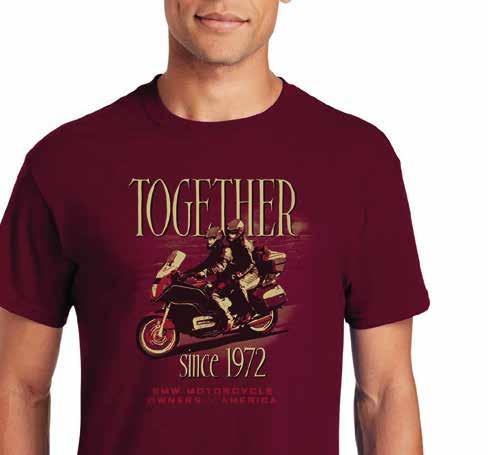
With Platinum Roadside Assistance and Tire Protection added to your BMW MOA membership, you’ll never ride alone again. BMW MOA’s 24/7 Platinum Roadside Assistance gets you to a repair facility fast and will even replace a punctured tire for free! All that for only $109 a year, which includes the cost of your MOA membership.

Join online at bmwmoa.org or convert your current BMW MOA membership by calling 864-438-0962. BMW MOA Platinum Roadside and Tire Protection, available exclusively for BMW MOA members.

Managing Editor BILL WIEGAND | bill@bmwmoa.org
Art Director KARIN HALKER | karin@bmwmoa.org
Digital Media Editor WES FLEMING | wes@bmwmoa.org
Associate Editor RON DAVIS
A ssociate Editor JOSE ABILES
Georg Thut, Eric Deyerl, Mac Robinson, Jim Wilson, Scott Saunders, Ross Thacker, Terry South, Bob Caverly, Adam Chandler, Wes and Paula Fitzer, Wes Fleming, Mark Thompson, Mark Barnes, Matt Parkhouse, Charlie Rubin, Alan Toney, Dustin Silvey, Nick Ienatsch, Sue Rihn, David Hrenchir.
MEMBERSHIP
Advertising Director CHRIS HUGHES | chris@bmwmoa.org
Business Development Director CHAD WARNER | chad@bmwmoa.org
Executive Director TED MOYER | ted@bmwmoa.org
BMW MOA Headquarters
2350 Hwy. 101 South, Greer, SC 29651 (864) 438-0962
Membership in the BMW Motorcycle Owners of America is open to all riders, regardless of brand affiliation. Although we are united by the BMW marque, adventure-minded motorcyclists will find a home here. Join today by visiting bmwmoa.org or call one of our friendly membership associates at 864-438-0962.
Primary Annual memberships are available in one year, two year or monthly options. Additional membership options include Primary Membership with Basic 25/100 Roadside Assistance, Primary Membership with Platinum Roadside Assistance, Digital Membership with Basic 25/100 Roadside Assistance, Digital Membership with Platinum Roadside Assistance. We also offer Roadside Assistance without an MOA Membership.
For a complete listing of membership options, please visit bmwmoa. org or call 864-438-0962.
BMW ON (ISSN:1080-5729) (USPS: 735-590) (BMW Owners News) is published monthly by BMW Motorcycle Owners of America Inc., 2350 Hwy 101 South, Greer, SC 29651. Periodicals postage paid at Pewaukee, Wisconsin and additional mailing offices. Opinions and positions stated in materials/articles herein are those of the authors and not by the fact of publication necessarily those of BMW MOA; publication of advertising material is not an endorsement by BMW MOA of the advertised product or service. The material is presented as information for the reader. BMW MOA does not perform independent research on submitted articles or advertising.
POSTMASTER: SEND ADDRESS CHANGES TO BMW ON, 2350 Hwy 101 South, Greer, SC 29651 © 2020 by BMW Motorcycle Owners of America Inc. All information furnished herein is provided by and for the members of BMW Motorcycle Owners of America, Inc. Unless otherwise stated, none of the information (including technical material) printed herein necessarily bears endorsement or approval by BMW MOA, BMW NA, the factory or the editors. The editors and publisher cannot be held liable for its accuracy. Printed in the USA. Volume 53, Number 4
 Mutual Admiration Rosie the Riveter admires the beauty and power she shares with BMW’s R 1250 GS in Plant City, Florida.
Mutual Admiration Rosie the Riveter admires the beauty and power she shares with BMW’s R 1250 GS in Plant City, Florida.
“
I joined the MOA because I love riding with like minded people and talking about bikes and different places to ride. Living in the Shenandoah Valley in VA affords me the opportunity to explore all the twisties and dirt roads my heart desires.
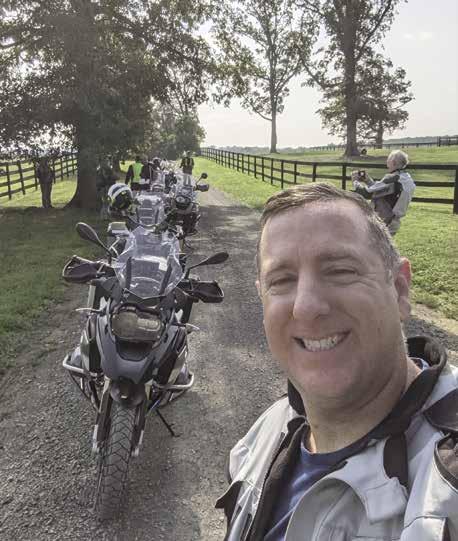
I’m also the membership chairman for the BMW Bikers of Metropolitan Washington if you’re in the area and need some folks to ride with!”

Do you know someone who would like to join?

Scan the code and give them their first year of membership free. Enter the activation code 50YRSON.
* First year free membership offer available to new MOA members only.
– Lester Gebski #232020





